Paul van Yperen's Blog, page 342
June 21, 2016
Mes p'tits (1923)
Italian strongman Ausonia and the French actors Gina Relly and Edouard Mathé were the stars of the French silent film Mes p'tits/Le calvaire d’un saltimbanque (Paul Barlatier, Charles Keppens, 1923), produced by the Marseille based Lauréa Films company. The film evolves in the circus milieu, as many other European silent films.

French postcard by Cinématographes Méric. Photo: publicity still for Mes p'tits (Paul Barlatier, Charles Keppens, 1923) with Ausonia (Mario Guaita).
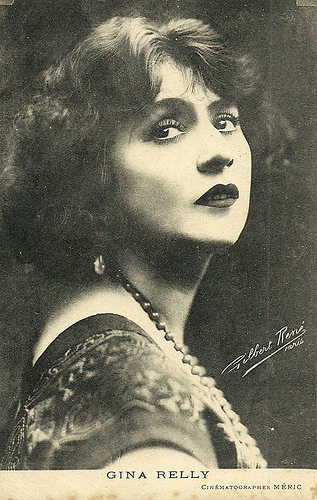
Gina Relly . French postcard by Cinématographes Méric. Photo: Gilbert René, Paris.
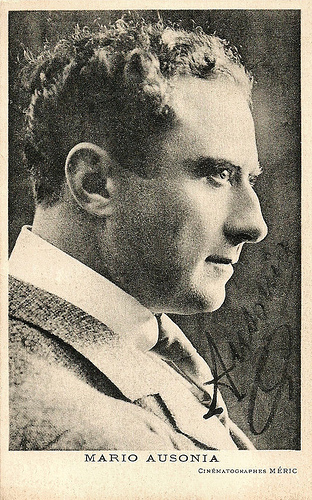
Mario Guaita aka Ausonia . French postcard by Cinématographes Méric.
Marseille
Athletic muscleman Mario Guaita aka Ausonia (1881-1956) was an Italian actor, director, producer and scriptwriter in the silent era. He had his international breakthrough with Spartaco (Enrico Vidali, 1913) and became a major actor in the Italian forzuto (strong man) genre.
In the early 1920s Ausonia moved to Marseille. In the French harbour city, he made a few films including Mes p'tits (1923) and he ran a cinema. Mes p'tits evolves in the circus and fairground milieu and was scripted by Ausonia's wife Renée Deliot aka de Liot.
Gina Relly (1891-1985) was a mesmerising actress of the French silent cinema. She starred opposite Léon Mathot in the beautiful French film serial L'empereur des pauvres/The Emperor of the poor (René Leprince, 1921).
Édouard Mathé (1886-1934) was an extremely popular French actor, in particular in the silent crime serials by Louis Feuillade. He was the protagonist of the crime serial Les Vampires (1915-1916) and also appeared in Feuillade's serials Judex (1916-1917), La nouvelle mission de Judex (1917-1918), Tih Minh (1918-1919), Vendémiaire (1918-1919) and Barrabas (1919).
Ausonia, Relly and Mathé also starred together in the film La course à l’amour/Love on the run (Paul Barlatier, Charles Keppens, 1924), again made in Marseille by Lauréa Films.
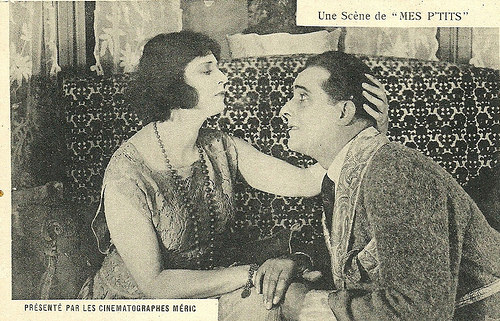
French postcard by Cinématographes Méric. Photo: publicity still for Mes p'tits (Paul Barlatier, Charles Keppens, 1923) with Gina Relly .
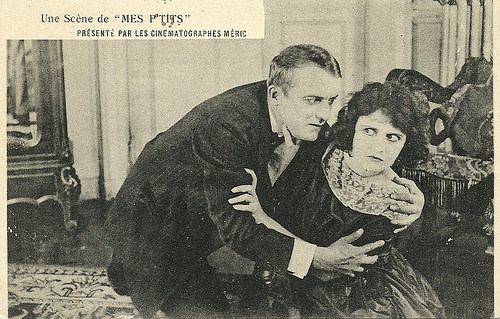
French postcard by Cinématographes Méric. Photo: publicity still for Mes p'tits (Paul Barlatier, Charles Keppens, 1923) with Gina Relly and Edouard Mathé .
An anonymous letter
In Mes p'tits the circus artist Ausonia ( Ausonia - Mario Guaita) lives with his two children in the circus Rancy. (The film was shot at the existing circus Rancy). Ausonia is a widower after his young wife fell from a trapeze. Only his children prevent him from committing suicide. All of the circus crew like Ausonia because of his strength and goodness. Wanda the amazon (Jane Rollette) is even in love with him and shows this indirectly by her affection to his children, but Ausonia is too deep in mourning to notice.
When the circus manager dies, his wife absolves the circus and all artists are on the street. In a nearby village Ausonia discovers a fairground booth of wrestlers and becomes the centre of attention, alas not only of the audience but also of the manager (Huguette Sandry), the widow of a wrestler. Ausonia instead is enamoured by her daughter Paulette ( Gina Relly ), whom the widow has promised to a jealous man, her cousin Frederick ( Edouard Mathé ).
What the others don’t know is that Paulette is secretly married to a young man from a rich British family. She confesses her secret to Ausonia and tells him also she is pregnant. Ausonia promises to help her, but because of the jealousy of Frederick and the widow, he is fired and once more on the streets.
Ausonia has odd jobs as carrier in the food halls, but when his little girl gets sick they head for the sea. Here he sees the booth of Paulette’s mother again but cannot reach Paulette. He finds an anonymous letter, though, asking to send the letter a.s.a.p. to someone else. He arrives at a villa where two men quarrel and one draws a gun. While the culprit flees, Ausonia helps the victim who seems to be dying and Ausonia is arrested for murder.
His children are brought to the countryside, to his mother, who dies when she reads about her son’s arrest. The children are on the street, on their own. Meanwhile Paulette, who had thrown the letter, is locked up by Frederick, who discovered her secret marriage and who afterwards shot her English husband.
Ausonia manages to escape from prison, returns to his natal village to discover, to his despair, that the house is empty, his mother dead and his children on the streets. He meets a small acrobatic guy (Riri Fortoul) and they form a duo. They travel the small fairgrounds, while he keeps looking for his children. His fate turns when he meets Wanda again, who has become a big music hall star, enlists Ausonia for the music-hall and hires detectives to help him.
When in a dance hall defending Wanda, Ausonia gets in a fight, and disgusted he leaves the city. By chance he manages to trace and find his children in the countryside, who are starving of hunger. He also discovers a villa where Frederick keeps Paulette locked up and the husband who survived the gunshot and now tries to free Paulette. After a fierce fight, Ausonia conquers Frederick and has him arrested, gives Paulette back to her husband and marries Wanda, thus giving the children a new mother.
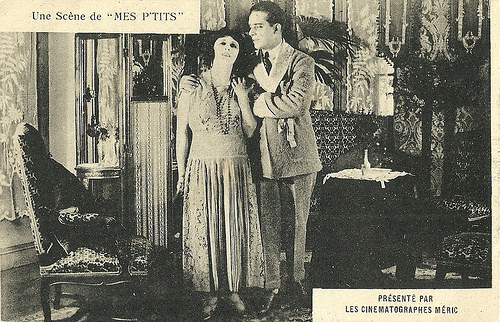
French postcard by Cinématographes Méric. Photo: publicity still for Mes p'tits (Paul Barlatier, Charles Keppens, 1923) with Gina Relly .
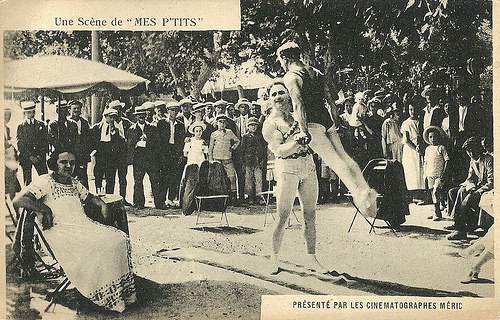
French postcard by Cinématographes Méric. Photo: publicity still for Mes p'tits (Paul Barlatier, Charles Keppens, 1923) with Ausonia (Mario Guaita).
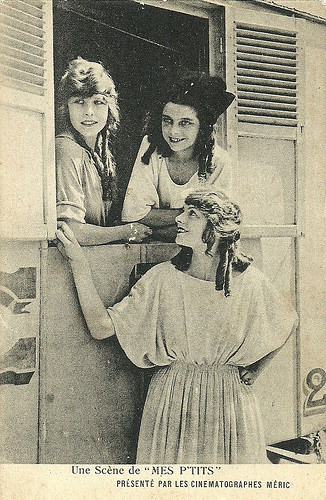
French postcard by Cinématographes Méric. Photo: publicity still for Mes p'tits (Paul Barlatier, Charles Keppens, 1923). The girl up right is Jane Rollette, who plays Wanda the amazon, in love with the leading character played by Mario Guaita / Ausonia.
Sources: Ciné Ressources (French), IMDb and the film copy.

French postcard by Cinématographes Méric. Photo: publicity still for Mes p'tits (Paul Barlatier, Charles Keppens, 1923) with Ausonia (Mario Guaita).

Gina Relly . French postcard by Cinématographes Méric. Photo: Gilbert René, Paris.

Mario Guaita aka Ausonia . French postcard by Cinématographes Méric.
Marseille
Athletic muscleman Mario Guaita aka Ausonia (1881-1956) was an Italian actor, director, producer and scriptwriter in the silent era. He had his international breakthrough with Spartaco (Enrico Vidali, 1913) and became a major actor in the Italian forzuto (strong man) genre.
In the early 1920s Ausonia moved to Marseille. In the French harbour city, he made a few films including Mes p'tits (1923) and he ran a cinema. Mes p'tits evolves in the circus and fairground milieu and was scripted by Ausonia's wife Renée Deliot aka de Liot.
Gina Relly (1891-1985) was a mesmerising actress of the French silent cinema. She starred opposite Léon Mathot in the beautiful French film serial L'empereur des pauvres/The Emperor of the poor (René Leprince, 1921).
Édouard Mathé (1886-1934) was an extremely popular French actor, in particular in the silent crime serials by Louis Feuillade. He was the protagonist of the crime serial Les Vampires (1915-1916) and also appeared in Feuillade's serials Judex (1916-1917), La nouvelle mission de Judex (1917-1918), Tih Minh (1918-1919), Vendémiaire (1918-1919) and Barrabas (1919).
Ausonia, Relly and Mathé also starred together in the film La course à l’amour/Love on the run (Paul Barlatier, Charles Keppens, 1924), again made in Marseille by Lauréa Films.

French postcard by Cinématographes Méric. Photo: publicity still for Mes p'tits (Paul Barlatier, Charles Keppens, 1923) with Gina Relly .

French postcard by Cinématographes Méric. Photo: publicity still for Mes p'tits (Paul Barlatier, Charles Keppens, 1923) with Gina Relly and Edouard Mathé .
An anonymous letter
In Mes p'tits the circus artist Ausonia ( Ausonia - Mario Guaita) lives with his two children in the circus Rancy. (The film was shot at the existing circus Rancy). Ausonia is a widower after his young wife fell from a trapeze. Only his children prevent him from committing suicide. All of the circus crew like Ausonia because of his strength and goodness. Wanda the amazon (Jane Rollette) is even in love with him and shows this indirectly by her affection to his children, but Ausonia is too deep in mourning to notice.
When the circus manager dies, his wife absolves the circus and all artists are on the street. In a nearby village Ausonia discovers a fairground booth of wrestlers and becomes the centre of attention, alas not only of the audience but also of the manager (Huguette Sandry), the widow of a wrestler. Ausonia instead is enamoured by her daughter Paulette ( Gina Relly ), whom the widow has promised to a jealous man, her cousin Frederick ( Edouard Mathé ).
What the others don’t know is that Paulette is secretly married to a young man from a rich British family. She confesses her secret to Ausonia and tells him also she is pregnant. Ausonia promises to help her, but because of the jealousy of Frederick and the widow, he is fired and once more on the streets.
Ausonia has odd jobs as carrier in the food halls, but when his little girl gets sick they head for the sea. Here he sees the booth of Paulette’s mother again but cannot reach Paulette. He finds an anonymous letter, though, asking to send the letter a.s.a.p. to someone else. He arrives at a villa where two men quarrel and one draws a gun. While the culprit flees, Ausonia helps the victim who seems to be dying and Ausonia is arrested for murder.
His children are brought to the countryside, to his mother, who dies when she reads about her son’s arrest. The children are on the street, on their own. Meanwhile Paulette, who had thrown the letter, is locked up by Frederick, who discovered her secret marriage and who afterwards shot her English husband.
Ausonia manages to escape from prison, returns to his natal village to discover, to his despair, that the house is empty, his mother dead and his children on the streets. He meets a small acrobatic guy (Riri Fortoul) and they form a duo. They travel the small fairgrounds, while he keeps looking for his children. His fate turns when he meets Wanda again, who has become a big music hall star, enlists Ausonia for the music-hall and hires detectives to help him.
When in a dance hall defending Wanda, Ausonia gets in a fight, and disgusted he leaves the city. By chance he manages to trace and find his children in the countryside, who are starving of hunger. He also discovers a villa where Frederick keeps Paulette locked up and the husband who survived the gunshot and now tries to free Paulette. After a fierce fight, Ausonia conquers Frederick and has him arrested, gives Paulette back to her husband and marries Wanda, thus giving the children a new mother.

French postcard by Cinématographes Méric. Photo: publicity still for Mes p'tits (Paul Barlatier, Charles Keppens, 1923) with Gina Relly .

French postcard by Cinématographes Méric. Photo: publicity still for Mes p'tits (Paul Barlatier, Charles Keppens, 1923) with Ausonia (Mario Guaita).

French postcard by Cinématographes Méric. Photo: publicity still for Mes p'tits (Paul Barlatier, Charles Keppens, 1923). The girl up right is Jane Rollette, who plays Wanda the amazon, in love with the leading character played by Mario Guaita / Ausonia.
Sources: Ciné Ressources (French), IMDb and the film copy.
Published on June 21, 2016 22:00
June 20, 2016
Juliette Mayniel
Doe-eyed French actress Juliette Mayniel (1936) appeared in 35 films and TV films between 1958 and 1978. Her film career made a jump start with two masterpieces, Claude Chabrol’s Les Cousins (1959) and the horror film Les Yeux Sans Visage (1960).
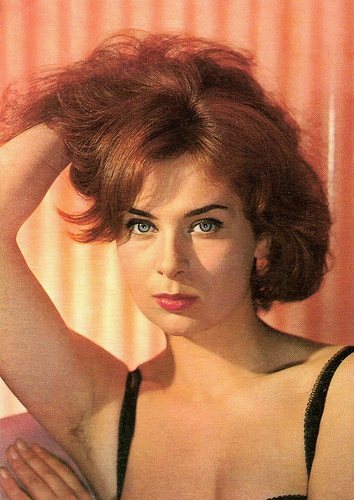
French postcard by E.D.U.G. (Editions du Globe), no. 45. Photo: Lucienne Chevert.
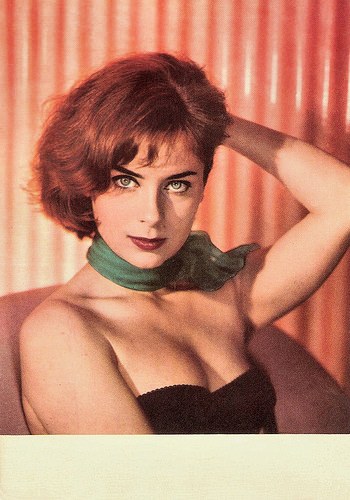
French postcard by Editions P.I., Paris, no. 1019. Photo: Sam Lévin.
Silver Bear
Juliette Mayniel was born in Saint Hippolyte, France in 1936.
Her first film appearance was an uncredited bit role in the comedy Premier mai/First of May (Luis Saslavsky, 1958) starring Yves Montand , but she had her breakthrough with her second film, the classic Nouvelle Vague film Les Cousins/The Cousins (Claude Chabrol, 1959). She is the girl between the two cousins, Jean-Claude Brialy and Gérard Blain . The film was an immediate success and remains one of Chabrol’s most striking films.
Next Mayniel had unwillingly her face removed by a mad doctor ( Pierre Brasseur ) in the masterpiece Les Yeux Sans Visage/Eyes Without a Face (Georges Franju, 1960). Hal Erickson at AllMovie calls the film ‘an unsettling, sometimes poetic horror film’: “Franju's haunting, muted handling of basic horror material is what lifts Eyes Without a Face out of the ordinary and into the realm of near-classic.”
James Travers adds at Le Film Guide : “Les Yeux sans visage differs from virtually all other films in the fantasy-horror genre. It doesn’t set out to shock us with gruesome images or insult our intelligence with an implausible plot or fantastic characters. Everything it shows us is frighteningly plausible, but presented to us in a dreamlike manner which, if anything, softens the horror of the situation. Crucially, it is not evil which provides the stimulus for the horror, but love, the love of a father determined to give his daughter back her life. In the end, it is the film’s haunting poetry, not its horror connotations, which have the deepest impact on the spectator.”
In the compelling WW II drama Kirmes/The Fair (Wolfgang Staudte, 1960) a young German soldier ( Götz George ) who had often been ordered to execute women and children deserts the army during WW II and tries to find a hiding place in his native village. He is sheltered by a priest and a young French woman (Mayniel) with whom he falls in love. At the 10th Berlin International Film Festival, Mayniel won the Silver Bear for Best Actress for her role.
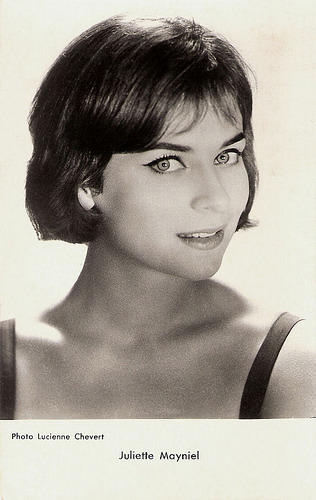
French postcard by Editions P.I., Paris, no. 1019A, presented by Les Carbones Korès Carboplane. Photo: Lucienne Chevert.
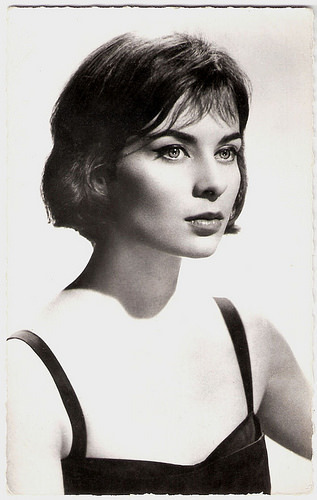
French postcard by Editions du Globe, Paris, no. 835. Photo: Lucienne Chevert.
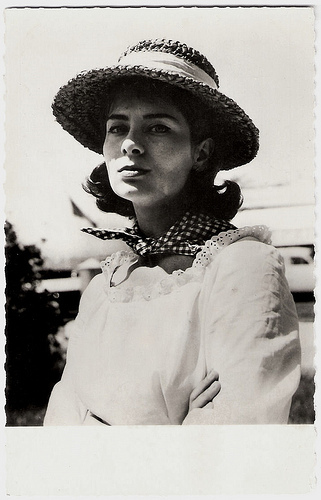
French postcard by Editions P.I., Paris, no. 1014. Photo: Noa.
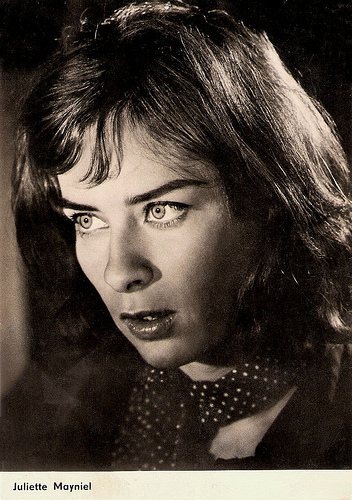
East-German starcard by VEB Progress Film-Vertrieb, Berlin, no. 2.003, 1964. Photo: publicity still for Kirmes/The Fair (Wolfgang Staudte, 1960).
Peplum and Giallo
Juliette Mayniel had a small part in Les Godelureaux/The Wise Guys (Claude Chabrol, 1961), a Nouvelle Vague drama about a trio of youths (including Jean-Claude Brialy and Bernadette Lafont ) looking to debunk hypocrisy wherever they find it. In Italy, she appeared in the Peplum La Guerra di Troia/The Trojan Horse (Giorgio Ferroni, 1962), a retelling of the final year of the siege of Troy from the point of view of Aeneas ( Steve Reeves ). Bruce Eder at AllMovie calls it: “one of the best examples of Italy's sword-and-sandal genre”.
She was reunited with director Claude Chabrol for Ophelia (1962), a curious, modern version of Hamlet, co-starring André Jocelyn and Alida Valli , and for Landru/Bluebeard (Claude Chabrol, 1963), a black comedy based on the dastardly deeds of serial killer Henri-Desire Landru (Charles Denner), who wined, dined, scammed, and dismembered over 10 women (including Danielle Darrieux and Michèle Morgan ) during WW I.
Juliette Mayniel was married to Robert Auboyneau till 1964. From 1964 until 1968 she was the partner of actor Vittorio Gassman . They have a son, actor Alessandro Gassman. During this period Mayniel didn’t work in the cinema.
In 1968 she returned as Circe in the Italian TV series L'odissea/The Odyssee (Franco Rossi, Piero Schivazappa, Mario Bava, 1968) based on Homer and starring Bekim Fehmiu and Irene Papas . She then appeared in the drama Scusi, Facciamo L'Amore?/Listen, Let's Make Love? (Vittorio Caprioli, 1968) about a young gigolo (Pierre Clementi). In Quella Piccola Differenza/That Little Difference (Duccio Tessari, 1970) she was the wife of a virile macho (Pino Caruso) who changes in three days in a woman.
Mayniel played the female lead in the Bud Spencer comedy Piedone Lo Sbirro/A Fistful of Hell (Steno, 1973) and in the soft sex comedy Peccati in Famiglia/Sins in the Family (Bruno Gaburro, 1975) opposite Michele Placido. On TV she appeared in Un anno di scuola/A Year of School (Franco Giraldi, 1977) with Mario Adorf , and in the mini-series Madame Bovary (Daniele D'Anza, 1978) with Carla Gravina as the heroin of Gustave Flaubert’s novel.
Her last film roles were a supporting part in the Giallo thriller Solamente Nero/The Blood Stained Shadow (Antonio Bido, 1978) with Stefania Casini and Massimo Serato , and eight years later another small part in Molly O (Gino Bortoloni, 1986). As herself, Juliette Mayniel appeared in the TV documentaries Portrait de Vittorio Gassman/Portrait of Vittorio Gassman (Pierre Laforêt, 1979) and Di padre in figlio/From Father To Son (Alessandro Gassman, Vittorio Gassman, 1982).
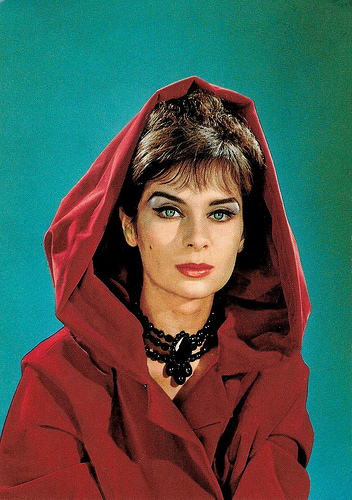
French postcard by Editions P.I., Paris, no. 1060. Photo: Sam Lévin.
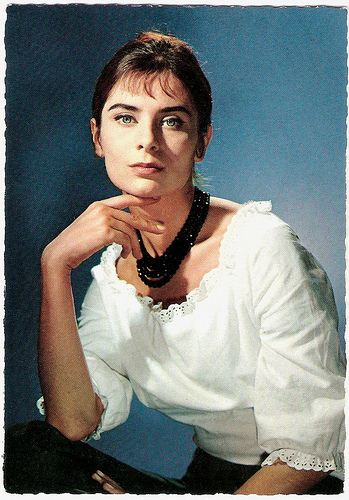
French postcard by E.D.U.G. (Editions du Globe), no. 72. Photo: Sam Lévin.
Sources: James Travers (Le Film Guide), Hal Erickson (AllMovie), John Conomos (Senses of Cinema), Wikipedia, and .

French postcard by E.D.U.G. (Editions du Globe), no. 45. Photo: Lucienne Chevert.

French postcard by Editions P.I., Paris, no. 1019. Photo: Sam Lévin.
Silver Bear
Juliette Mayniel was born in Saint Hippolyte, France in 1936.
Her first film appearance was an uncredited bit role in the comedy Premier mai/First of May (Luis Saslavsky, 1958) starring Yves Montand , but she had her breakthrough with her second film, the classic Nouvelle Vague film Les Cousins/The Cousins (Claude Chabrol, 1959). She is the girl between the two cousins, Jean-Claude Brialy and Gérard Blain . The film was an immediate success and remains one of Chabrol’s most striking films.
Next Mayniel had unwillingly her face removed by a mad doctor ( Pierre Brasseur ) in the masterpiece Les Yeux Sans Visage/Eyes Without a Face (Georges Franju, 1960). Hal Erickson at AllMovie calls the film ‘an unsettling, sometimes poetic horror film’: “Franju's haunting, muted handling of basic horror material is what lifts Eyes Without a Face out of the ordinary and into the realm of near-classic.”
James Travers adds at Le Film Guide : “Les Yeux sans visage differs from virtually all other films in the fantasy-horror genre. It doesn’t set out to shock us with gruesome images or insult our intelligence with an implausible plot or fantastic characters. Everything it shows us is frighteningly plausible, but presented to us in a dreamlike manner which, if anything, softens the horror of the situation. Crucially, it is not evil which provides the stimulus for the horror, but love, the love of a father determined to give his daughter back her life. In the end, it is the film’s haunting poetry, not its horror connotations, which have the deepest impact on the spectator.”
In the compelling WW II drama Kirmes/The Fair (Wolfgang Staudte, 1960) a young German soldier ( Götz George ) who had often been ordered to execute women and children deserts the army during WW II and tries to find a hiding place in his native village. He is sheltered by a priest and a young French woman (Mayniel) with whom he falls in love. At the 10th Berlin International Film Festival, Mayniel won the Silver Bear for Best Actress for her role.

French postcard by Editions P.I., Paris, no. 1019A, presented by Les Carbones Korès Carboplane. Photo: Lucienne Chevert.

French postcard by Editions du Globe, Paris, no. 835. Photo: Lucienne Chevert.

French postcard by Editions P.I., Paris, no. 1014. Photo: Noa.

East-German starcard by VEB Progress Film-Vertrieb, Berlin, no. 2.003, 1964. Photo: publicity still for Kirmes/The Fair (Wolfgang Staudte, 1960).
Peplum and Giallo
Juliette Mayniel had a small part in Les Godelureaux/The Wise Guys (Claude Chabrol, 1961), a Nouvelle Vague drama about a trio of youths (including Jean-Claude Brialy and Bernadette Lafont ) looking to debunk hypocrisy wherever they find it. In Italy, she appeared in the Peplum La Guerra di Troia/The Trojan Horse (Giorgio Ferroni, 1962), a retelling of the final year of the siege of Troy from the point of view of Aeneas ( Steve Reeves ). Bruce Eder at AllMovie calls it: “one of the best examples of Italy's sword-and-sandal genre”.
She was reunited with director Claude Chabrol for Ophelia (1962), a curious, modern version of Hamlet, co-starring André Jocelyn and Alida Valli , and for Landru/Bluebeard (Claude Chabrol, 1963), a black comedy based on the dastardly deeds of serial killer Henri-Desire Landru (Charles Denner), who wined, dined, scammed, and dismembered over 10 women (including Danielle Darrieux and Michèle Morgan ) during WW I.
Juliette Mayniel was married to Robert Auboyneau till 1964. From 1964 until 1968 she was the partner of actor Vittorio Gassman . They have a son, actor Alessandro Gassman. During this period Mayniel didn’t work in the cinema.
In 1968 she returned as Circe in the Italian TV series L'odissea/The Odyssee (Franco Rossi, Piero Schivazappa, Mario Bava, 1968) based on Homer and starring Bekim Fehmiu and Irene Papas . She then appeared in the drama Scusi, Facciamo L'Amore?/Listen, Let's Make Love? (Vittorio Caprioli, 1968) about a young gigolo (Pierre Clementi). In Quella Piccola Differenza/That Little Difference (Duccio Tessari, 1970) she was the wife of a virile macho (Pino Caruso) who changes in three days in a woman.
Mayniel played the female lead in the Bud Spencer comedy Piedone Lo Sbirro/A Fistful of Hell (Steno, 1973) and in the soft sex comedy Peccati in Famiglia/Sins in the Family (Bruno Gaburro, 1975) opposite Michele Placido. On TV she appeared in Un anno di scuola/A Year of School (Franco Giraldi, 1977) with Mario Adorf , and in the mini-series Madame Bovary (Daniele D'Anza, 1978) with Carla Gravina as the heroin of Gustave Flaubert’s novel.
Her last film roles were a supporting part in the Giallo thriller Solamente Nero/The Blood Stained Shadow (Antonio Bido, 1978) with Stefania Casini and Massimo Serato , and eight years later another small part in Molly O (Gino Bortoloni, 1986). As herself, Juliette Mayniel appeared in the TV documentaries Portrait de Vittorio Gassman/Portrait of Vittorio Gassman (Pierre Laforêt, 1979) and Di padre in figlio/From Father To Son (Alessandro Gassman, Vittorio Gassman, 1982).

French postcard by Editions P.I., Paris, no. 1060. Photo: Sam Lévin.

French postcard by E.D.U.G. (Editions du Globe), no. 72. Photo: Sam Lévin.
Sources: James Travers (Le Film Guide), Hal Erickson (AllMovie), John Conomos (Senses of Cinema), Wikipedia, and .
Published on June 20, 2016 22:00
June 19, 2016
Françoise Hardy
French singer, actress and astrologer Françoise Hardy (1944) was the original Yé-yé girl with her trademark jeans and leather jacket. She was one of the most popular French music stars of the 1960s, and occasionally appeared in international films. She represented Monaco at the Eurovision Song Contest in 1963, and placed 6th. Nowadays, Françoise Hardy is still an icon of fashion, music and style, and she continues to record albums.
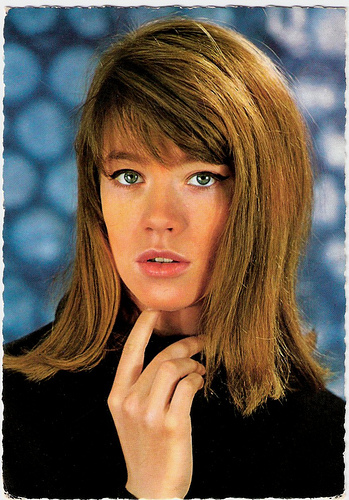
French postcard by Editions Publistar, no. 788. Photo: Nisak.
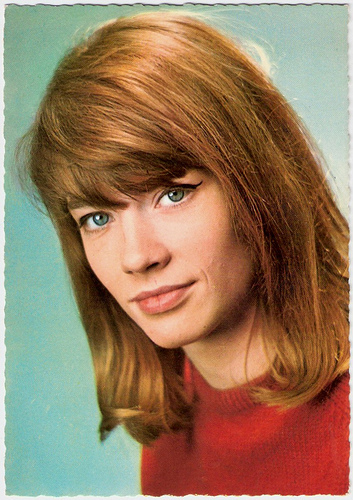
French postcard by E.D.U.G. Photo: Sam Lévin.
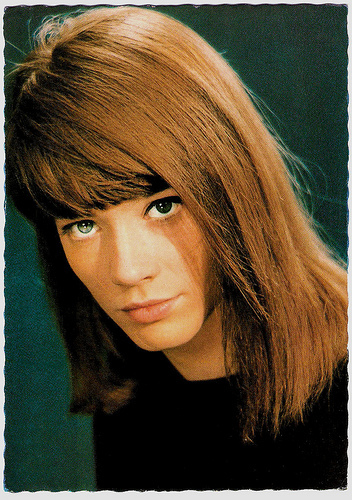
French postcard by E.D.U.G., no. 283. Photo: Sam Lévin.
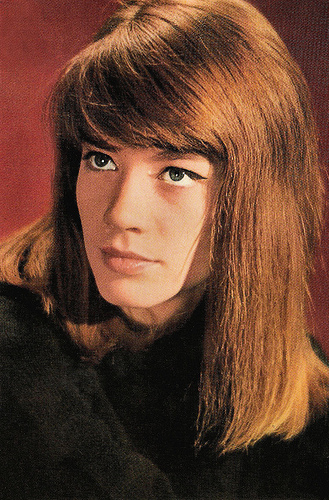
French postcard by E.D.U.G., no. 313. Photo: Sam Lévin.
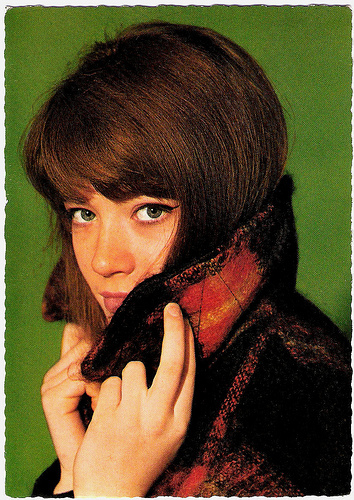
French postcard by Publistar, no. 858. Photo: Pierre Spitzer / Disques Vogue.
Ultimate Girl-next-door Made Good
Françoise Madeleine Hardy was born in 1944 in Paris. She grew up with her younger sister Michèle Hardy in the 9th arrondissement. Their unmarried mother worked as an assistant accountant. The introvert Françoise was sent to La Bruyère, a rather strict convent school for girls. The tall, thin girl with long legs grew up to be an extremely studious and pious student who found it difficult to overcome her shyness.
On her sixteenth birthday, she received a guitar from her mostly absent father as a reward for passing her baccalaureate. She started to write her own songs in her free time, inspired by the music she heard on the radio. Françoise was a passionate music fan, listening to Georges Guétary ’s operettas from an early age, before progressing to French chanson stars Charles Trenet and Cora Vaucaire.
She enrolled at the Petit Conservatoire de Mireille (a legendary 1960s singing school) and at the Political Science Faculty at the Sorbonne. In late 1961 she answered a newspaper advertisement looking for young singers, and Hardy signed her first contract with the record label Vogue at the age of 17. With her shy temperament, her soft voice and her quiet natural beauty, Françoise Hardy was the ultimate girl-next-door made good.
In April 1962, her first record Oh Oh Chéri appeared, written by Johnny Hallyday 's habitual writing duo, and three of Françoise’s own compositions including Tous Les Garçons Et Les Filles (All the boys and girls).
This last track greatly impressed Daniel Filipacchi, presenter of Radio Europe’s cult music show Salut les Copains, who went on to play the song almost non-stop. It became a phenomenal box office hit, riding the wave of the Yé-yé (or Yeah-yeah - the French rock and roll craze), with two million sales.
She first appeared on television in 1962 during an interlude in a programme reporting the results of a presidential referendum. The shy Hardy suddenly found herself at the very forefront of the French music scene.
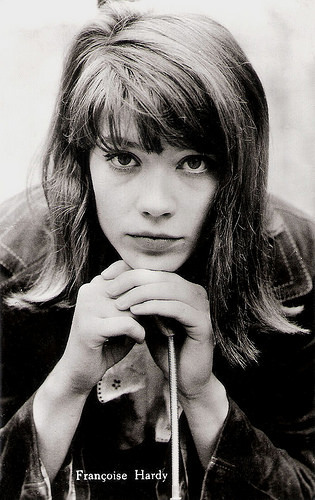
Dutch postcard by Gebr. Spanjersberg N.V., Rotterdam, no. ?103. Photo: Vogue.
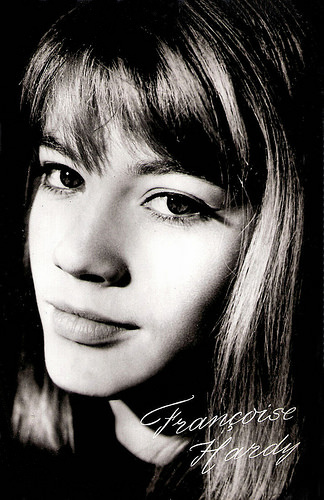
Dutch postcard by 't Sticht, Utrecht, no. AX 5543.
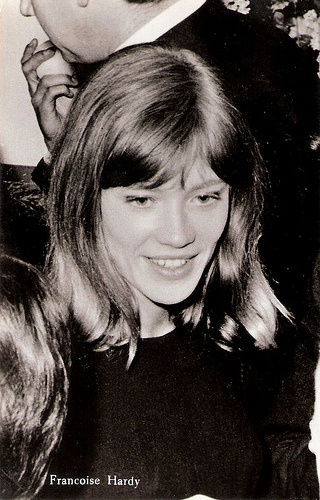
Dutch postcard by Gebr. Spanjersberg N.V., Rotterdam (SPARO). Photo: Vogue.
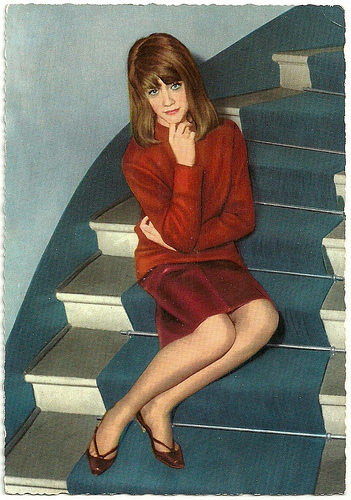
German postcard by Krüger. Photo: Pierre Spitzer.
Modern Young Trend-setter
Françoise Hardy soon began to appear on the cover of all the top music magazines of the day. During a photo shoot for the magazine Salut les copains, she fell in love with photographer Jean-Marie Perier. Like a Pygmalion, he transformed the young singer from a shy, gauche-looking schoolgirl into a modern young trend-setter.
She made her first film appearance opposite Jean-Louis Trintignant in the comedy Château en Suède/Nutty, Naughty Chateau (Roger Vadim, 1963) based on a novel by Françoise Sagan. According to RFI Musique , "Françoise’s role in the film earned her much acclaim, and many critics declared that a great acting career lay ahead of her".
In the following years, she appeared in an uncredited appearance in the final scene of What's New Pussycat? (Clive Donner, Richard Talmadge, 1965) starring Peter O'Toole , in the leading role of the crime drama Une Balle au Cœur/Devil at My Heels (Jean-Daniel Pollet, 1965) opposite Samy Frey , in a scene from the Nouvelle Vague masterpiece Masculin, féminin (Jean-Luc Godard, 1966) with Jean-Pierre Léaud, and in Grand Prix (John Frankenheimer, 1966) starring James Garner. Other films in which she appeared include Les colombes/The Doves (Jean-Claude Lord, 1972) and the TV musical Émilie jolie (Jean-Christophe Averty, 1980) with Georges Brassens.
Her songs are featured on many film soundtracks. Tous Les Garçons et Les Filles for instance plays during the British film Metroland (Philip Saville, 1997), during The Dreamers (Bernardo Betrtolucci, 2003), and during The Statement (Norman Jewison, 2003) and another song L'Amitié (1965) plays during the end credits of Les Invasions barbares/The Barbarian Invasions (Denys Arcand, 2003) which won the Academy Award for Best Foreign Language Film. Le temps de l'amour can be heard on the soundtracks of Moonrise Kingdom (Wes Anderson, 2012) and Trainyard Dogs (Ryan Prince, 2016).
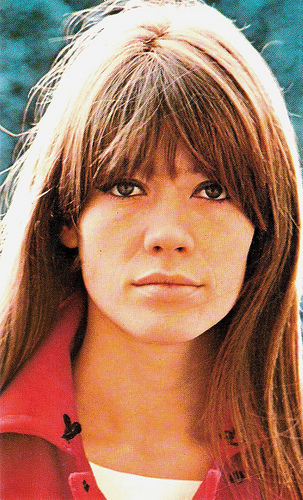
French postcard by Publistar, no. 1362. Photo: Jean-Marie Perier.
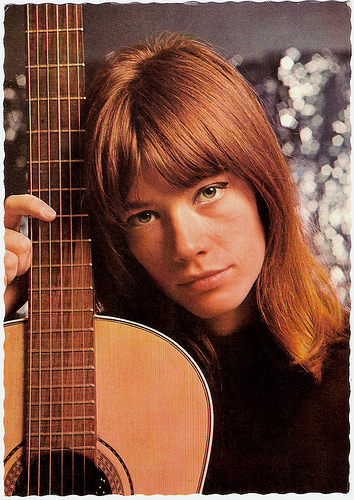
French postcard by Starcolor, Marseille, no. 951. Photo: Patrick de Mervellec.
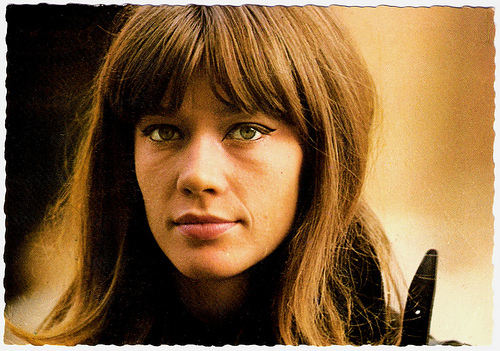
French postcard by Starcolor, Marseille, no. 972. Photo: Jean-Marie Perier.
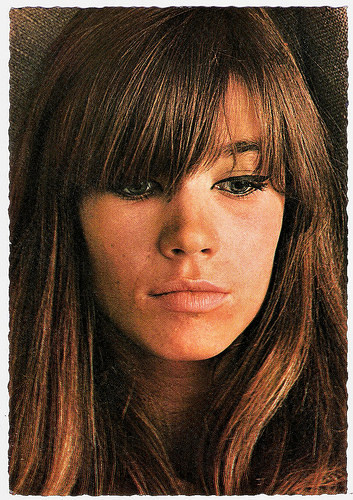
French postcard by Publistar, Paris, no. 1134. Photo: Jean-Marie Perier.
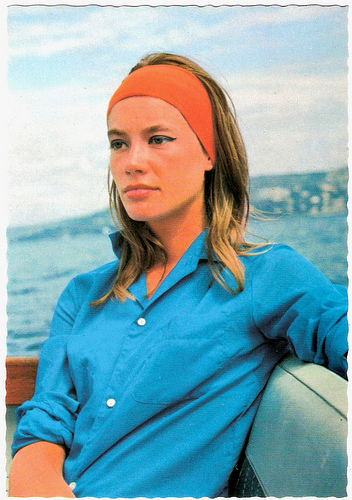
German postcard by ISV, no. H 132.
Sheer Force of the Emotion
Françoise Hardy was not really interested in anything other than her singing career, and it went smoothly. In 1963 her début album had been released to general critical acclaim. That year she also came fifth for Monaco (!) in the Eurovision Song Contest with L'amour s'en va (Love Goes Away), and she was awarded the Grand Prix Du Disque of the Charles Cros Academy.
The following year she set off on an extensive European tour which included an appearance in Italy at the famous San Remo Festival. Here she performed Parla mi di te (Tell me about you). She sings in French, English, Italian, Spanish, and German. In spite of the fact that Hardy's voice was neither extremely powerful nor strikingly unusual, the singer would continue to woo audiences throughout her career with her exceptional lyrics and the sheer force of the emotion which she put into her performances.
In 1981, she married her long-time companion, actor/singer Jacques Dutronc , with whom she had had a son, Thomas Dutronc, in 1973. In 1994, she collaborated with the British pop group Blur for their La Comedie version of To The End, and in 2000, she made a comeback with the album Clair Obscur. Her son played guitar and her husband sang the duet Puisque Vous Partez En Voyage (Till You Leave on a Voyage). Iggy Pop and Étienne Daho also took part.
Françoise Hardy continues her successful career of more than 50 years. In 2010, she released a new album of original material, La Pluie sans parapluie (Rain without an umbrella). In 2012, Hardy marked her 50-year career by publishing her 27th album and the book L'Amour fou. In 2015, after two years of silence, a second book was published under the title Avis non-autorisé... (Unauthorized opinion). In this book, she reflects on old age, her interests and her annoyances. She lives near Paris and although Dutronc lives in Monticello, Corsica, they remain married.
Françoise Hardy sings Tous les garçons et les filles. Source: keaneperson (YouTube). This hilarious and dizzy-making clip was produced by Claude Lelouch in 1963 for Scopitone.
Françoise Hardy sings L'amour s'en va at the Eurovision Contest of 1963. Source: Joao Velada (YouTube).
Francoise Hardy sings Comment te dire adieu (How to say farewell) in 1968. Source: Etoile Matutine (YouTube). This hit song was written by Serge Gainsbourg .
Scene from What's New Pussycat (1965) with Peter O'Toole , Romy Schneider and Peter Sellers. Source: Rocco And Fratelli (YouTube).
Sources: Warren Silbert (Françoise Hardy - All Over the World), Frankenstein (Commencement - French), Radio France Internationale (French), Official Françoise Hardy website (French), Wikipedia, and .

French postcard by Editions Publistar, no. 788. Photo: Nisak.

French postcard by E.D.U.G. Photo: Sam Lévin.

French postcard by E.D.U.G., no. 283. Photo: Sam Lévin.

French postcard by E.D.U.G., no. 313. Photo: Sam Lévin.

French postcard by Publistar, no. 858. Photo: Pierre Spitzer / Disques Vogue.
Ultimate Girl-next-door Made Good
Françoise Madeleine Hardy was born in 1944 in Paris. She grew up with her younger sister Michèle Hardy in the 9th arrondissement. Their unmarried mother worked as an assistant accountant. The introvert Françoise was sent to La Bruyère, a rather strict convent school for girls. The tall, thin girl with long legs grew up to be an extremely studious and pious student who found it difficult to overcome her shyness.
On her sixteenth birthday, she received a guitar from her mostly absent father as a reward for passing her baccalaureate. She started to write her own songs in her free time, inspired by the music she heard on the radio. Françoise was a passionate music fan, listening to Georges Guétary ’s operettas from an early age, before progressing to French chanson stars Charles Trenet and Cora Vaucaire.
She enrolled at the Petit Conservatoire de Mireille (a legendary 1960s singing school) and at the Political Science Faculty at the Sorbonne. In late 1961 she answered a newspaper advertisement looking for young singers, and Hardy signed her first contract with the record label Vogue at the age of 17. With her shy temperament, her soft voice and her quiet natural beauty, Françoise Hardy was the ultimate girl-next-door made good.
In April 1962, her first record Oh Oh Chéri appeared, written by Johnny Hallyday 's habitual writing duo, and three of Françoise’s own compositions including Tous Les Garçons Et Les Filles (All the boys and girls).
This last track greatly impressed Daniel Filipacchi, presenter of Radio Europe’s cult music show Salut les Copains, who went on to play the song almost non-stop. It became a phenomenal box office hit, riding the wave of the Yé-yé (or Yeah-yeah - the French rock and roll craze), with two million sales.
She first appeared on television in 1962 during an interlude in a programme reporting the results of a presidential referendum. The shy Hardy suddenly found herself at the very forefront of the French music scene.

Dutch postcard by Gebr. Spanjersberg N.V., Rotterdam, no. ?103. Photo: Vogue.

Dutch postcard by 't Sticht, Utrecht, no. AX 5543.

Dutch postcard by Gebr. Spanjersberg N.V., Rotterdam (SPARO). Photo: Vogue.

German postcard by Krüger. Photo: Pierre Spitzer.
Modern Young Trend-setter
Françoise Hardy soon began to appear on the cover of all the top music magazines of the day. During a photo shoot for the magazine Salut les copains, she fell in love with photographer Jean-Marie Perier. Like a Pygmalion, he transformed the young singer from a shy, gauche-looking schoolgirl into a modern young trend-setter.
She made her first film appearance opposite Jean-Louis Trintignant in the comedy Château en Suède/Nutty, Naughty Chateau (Roger Vadim, 1963) based on a novel by Françoise Sagan. According to RFI Musique , "Françoise’s role in the film earned her much acclaim, and many critics declared that a great acting career lay ahead of her".
In the following years, she appeared in an uncredited appearance in the final scene of What's New Pussycat? (Clive Donner, Richard Talmadge, 1965) starring Peter O'Toole , in the leading role of the crime drama Une Balle au Cœur/Devil at My Heels (Jean-Daniel Pollet, 1965) opposite Samy Frey , in a scene from the Nouvelle Vague masterpiece Masculin, féminin (Jean-Luc Godard, 1966) with Jean-Pierre Léaud, and in Grand Prix (John Frankenheimer, 1966) starring James Garner. Other films in which she appeared include Les colombes/The Doves (Jean-Claude Lord, 1972) and the TV musical Émilie jolie (Jean-Christophe Averty, 1980) with Georges Brassens.
Her songs are featured on many film soundtracks. Tous Les Garçons et Les Filles for instance plays during the British film Metroland (Philip Saville, 1997), during The Dreamers (Bernardo Betrtolucci, 2003), and during The Statement (Norman Jewison, 2003) and another song L'Amitié (1965) plays during the end credits of Les Invasions barbares/The Barbarian Invasions (Denys Arcand, 2003) which won the Academy Award for Best Foreign Language Film. Le temps de l'amour can be heard on the soundtracks of Moonrise Kingdom (Wes Anderson, 2012) and Trainyard Dogs (Ryan Prince, 2016).

French postcard by Publistar, no. 1362. Photo: Jean-Marie Perier.

French postcard by Starcolor, Marseille, no. 951. Photo: Patrick de Mervellec.

French postcard by Starcolor, Marseille, no. 972. Photo: Jean-Marie Perier.

French postcard by Publistar, Paris, no. 1134. Photo: Jean-Marie Perier.

German postcard by ISV, no. H 132.
Sheer Force of the Emotion
Françoise Hardy was not really interested in anything other than her singing career, and it went smoothly. In 1963 her début album had been released to general critical acclaim. That year she also came fifth for Monaco (!) in the Eurovision Song Contest with L'amour s'en va (Love Goes Away), and she was awarded the Grand Prix Du Disque of the Charles Cros Academy.
The following year she set off on an extensive European tour which included an appearance in Italy at the famous San Remo Festival. Here she performed Parla mi di te (Tell me about you). She sings in French, English, Italian, Spanish, and German. In spite of the fact that Hardy's voice was neither extremely powerful nor strikingly unusual, the singer would continue to woo audiences throughout her career with her exceptional lyrics and the sheer force of the emotion which she put into her performances.
In 1981, she married her long-time companion, actor/singer Jacques Dutronc , with whom she had had a son, Thomas Dutronc, in 1973. In 1994, she collaborated with the British pop group Blur for their La Comedie version of To The End, and in 2000, she made a comeback with the album Clair Obscur. Her son played guitar and her husband sang the duet Puisque Vous Partez En Voyage (Till You Leave on a Voyage). Iggy Pop and Étienne Daho also took part.
Françoise Hardy continues her successful career of more than 50 years. In 2010, she released a new album of original material, La Pluie sans parapluie (Rain without an umbrella). In 2012, Hardy marked her 50-year career by publishing her 27th album and the book L'Amour fou. In 2015, after two years of silence, a second book was published under the title Avis non-autorisé... (Unauthorized opinion). In this book, she reflects on old age, her interests and her annoyances. She lives near Paris and although Dutronc lives in Monticello, Corsica, they remain married.
Françoise Hardy sings Tous les garçons et les filles. Source: keaneperson (YouTube). This hilarious and dizzy-making clip was produced by Claude Lelouch in 1963 for Scopitone.
Françoise Hardy sings L'amour s'en va at the Eurovision Contest of 1963. Source: Joao Velada (YouTube).
Francoise Hardy sings Comment te dire adieu (How to say farewell) in 1968. Source: Etoile Matutine (YouTube). This hit song was written by Serge Gainsbourg .
Scene from What's New Pussycat (1965) with Peter O'Toole , Romy Schneider and Peter Sellers. Source: Rocco And Fratelli (YouTube).
Sources: Warren Silbert (Françoise Hardy - All Over the World), Frankenstein (Commencement - French), Radio France Internationale (French), Official Françoise Hardy website (French), Wikipedia, and .
Published on June 19, 2016 22:00
June 18, 2016
Siegfried Rauch
Siegfried Rauch (1932) is a popular German film and television actor. In the 1970s he appeared in several international films. He has been an actor for over 45 years, in approximately 200 productions.
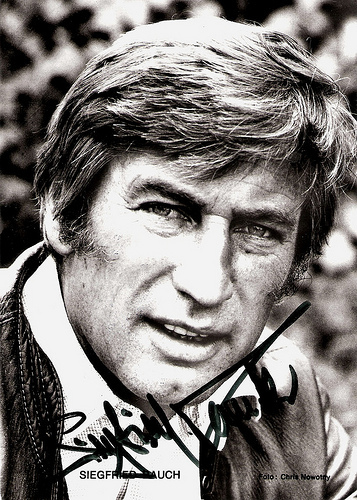
German postcard by Franz Josef Rüdel, Filmpostkartenverlag, Hamburg. Photo: Chris Nowotny, München.
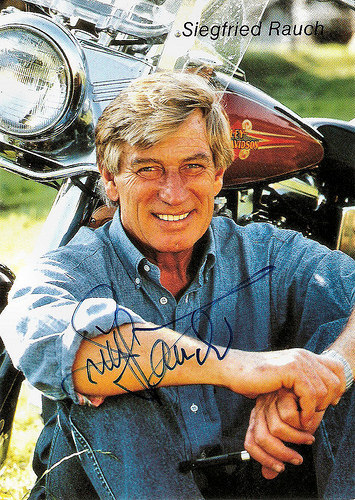
German promotion card by Süd Golf, Wolfratshausen.
Steve McQueen's rival
Siegfried Rauch was born in Landsberg am Lech, Germany, in 1932. Rauch studied drama at the Ludwig Maximilian University of Munich. Additionally, he attended private drama lessons. Since 1958, he has performed at different theatres, beginning with Bremen (until 1962), and followed by Berlin, Munich and Hamburg.
In 1956, he started his film career in the Heimatfilms Die Geierwally/Vulture Wally (Frantisek Cáp, 1956), starring Barbara Rütting and Carl Möhner , and Der Jäger von Fall/The Hunter of Fall (Gustav Ucicky, 1956), featuring Rudolf Lenz.
During the 1960s, he appeared in European coproductions like the Eurospy film Kommissar X - Drei gelbe Katzen/Death is Nimble, Death is Quick (Rudolf Zehetgruber, Gianfranco Parolini, 1966), starring Tony Kendall and Brad Harris . It is the second of seven films, loosely based on the Kommissar X #73 detective novel from the Pabel Moewig publishing house.
Another Eurospy film in which he played a supporting part was Mister Dynamit - Morgen küßt euch der Tod/Spy Today, Die Tomorrow (Franz Josef Gottlieb, 1967) starring Lex Barker and Maria Perschy . Rauch also appeared in the thriller Im Banne des Unheimlichen/The Zombie Walks (Alfred Vohrer, 1968) starring Joachim Fuchsberger . It is part of the series of German screen adaptations of Edgar Wallace's thriller novels.
In the 1970s Rauch often worked in Hollywood. He appeared opposite George C. Scott in the war epic Patton (Franklin J. Schaffner, 1970) as Captain Steiger. The film won seven Oscars, including Best Picture. In Le Mans (Lee H. Katzin, 1971), Rauch played the race driver Erich Stahler who is Steve McQueen's rival. Other Hollywood productions in which Rauch appeared were the war film The Eagle Has Landed (John Sturges, 1976) with Michael Caine , and Escape to Athena (George P. Cosmatos, 1979), starring Roger Moore and David Niven .
In Samuel Fuller's World War II war film The Big Red One (1980), Rauch played a German army sergeant, the opposite of Lee Marvin's character, who experiences the same events as Marvin only from a German perspective. Mark Deming at AllMovie : “Unfortunately, Fuller was forced by his producers to work with a scaled-down budget, and he did not have final cut on the film; after his first rough cut ran nearly four-and-a-half hours, the studio took over editing on the project, and Fuller was vocally unhappy with the final results. In 2003, critic and film historian Richard Schickel initiated an effort to restore The Big Red One to a form that more closely resembled Fuller's original vision.“ Schickel's reconstruction received enthusiastic reviews when it went into limited release in the fall of 2004.
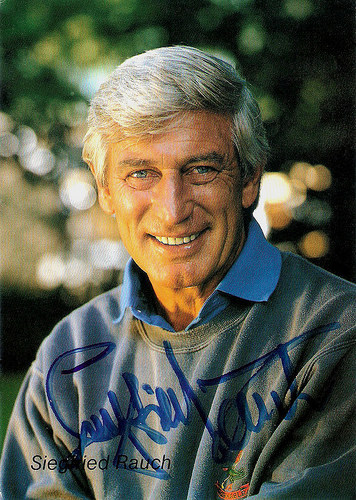
German autograph card.
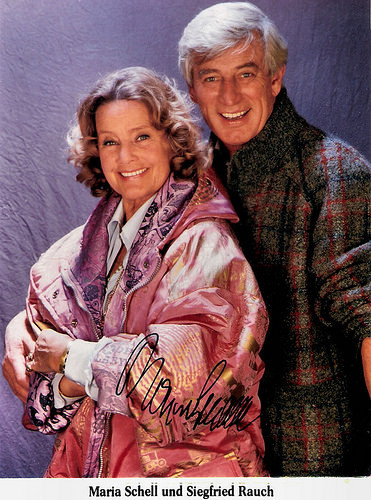
German autograph card. Publicity still for the TV series Die glückliche Familie/The Happy Family (1987-1991) with Maria Schell .

German autograph card by 2DF. Photo: ZDF / Dirk Bartling. Publicity still for the TV series Das Traumschiff/The Dream Boat (1997-2013).
It Can't Always Be Caviar
Siegfried Rauch continued to work in the German cinema and also on TV. Her played in a new version of the Heimatfilm Der Jäger von Fall/The Hunter of Fall (Harald Reinl, 1974).
His most famous leading act on German television was Thomas Lieven in the mini-series Es muss nicht immer Kaviar sein/It Can't Always Be Caviar (Thomas Engel, 1977), based on the international bestseller by Johannes Mario Simmel. The series is unique for providing a little cooking show at the end of each episode. The book also includes recipes because Thomas Lieven is an accomplished amateur cook. The 13 episodes were very popular in Germany during the 1970s and 1980s, and have since attained cult-status.
Rauch’s various other roles on television established his career as an actor in Germany. Since 1997, Rauch has continuously appeared in Das Traumschiff/The Dreamboat (1997-2013), one of the most-watched television series in Germany. He also appeared in other long-running hit-series like Die Landärztin/The Country Doctor (2006-2011), the Das Traumschiff spin-off Kreuzfahrt ins Glück/Cruise to Happiness (2007-2013) and Der Bergdoktor/Mountain Medic (2008-2016, 96 episodes).
Internationally he appeared in films like the science fiction-horror film Contamination (Luigi Cozzi, 1980) starring Ian McCulloch, the action film Der Stein des Todes/Perahera, Death Stone (Franz Josef Gottlieb, 1985) and another actioner Feuer, Eis und Dynamit/Fire, Ice and Dynamite (Willy Bogner, 1990), starring Roger Moore .
Siegfried Rauch, also known as ‘Sigi’, currently lives near on his farm near Weilheim in the Bavarian Alps. Rauch is married to Karin and has two sons, Jakob and Benedikt, and one grandchild. Steve McQueen was the Godfather of his son Jakob.
Trailer Kommissar X - Drei gelbe Katzen/Death is Nimble, Death is Quick (1966). Source: Italo-Cinema Trailer (YouTube).
Trailer for Mister Dynamit - Morgen küßt euch der Tod/Spy Today, Die Tomorrow (1967). Source: Italo-Cinema Trailer (YouTube).
Trailer Le Mans (1971). Source: Umbrella Entertainment (YouTube).
Trailer The Big Red One (1980). Source: Video Detective (YouTube).
Sources: Mark Deming (AllMovie), Wikipedia (English and German), and .

German postcard by Franz Josef Rüdel, Filmpostkartenverlag, Hamburg. Photo: Chris Nowotny, München.

German promotion card by Süd Golf, Wolfratshausen.
Steve McQueen's rival
Siegfried Rauch was born in Landsberg am Lech, Germany, in 1932. Rauch studied drama at the Ludwig Maximilian University of Munich. Additionally, he attended private drama lessons. Since 1958, he has performed at different theatres, beginning with Bremen (until 1962), and followed by Berlin, Munich and Hamburg.
In 1956, he started his film career in the Heimatfilms Die Geierwally/Vulture Wally (Frantisek Cáp, 1956), starring Barbara Rütting and Carl Möhner , and Der Jäger von Fall/The Hunter of Fall (Gustav Ucicky, 1956), featuring Rudolf Lenz.
During the 1960s, he appeared in European coproductions like the Eurospy film Kommissar X - Drei gelbe Katzen/Death is Nimble, Death is Quick (Rudolf Zehetgruber, Gianfranco Parolini, 1966), starring Tony Kendall and Brad Harris . It is the second of seven films, loosely based on the Kommissar X #73 detective novel from the Pabel Moewig publishing house.
Another Eurospy film in which he played a supporting part was Mister Dynamit - Morgen küßt euch der Tod/Spy Today, Die Tomorrow (Franz Josef Gottlieb, 1967) starring Lex Barker and Maria Perschy . Rauch also appeared in the thriller Im Banne des Unheimlichen/The Zombie Walks (Alfred Vohrer, 1968) starring Joachim Fuchsberger . It is part of the series of German screen adaptations of Edgar Wallace's thriller novels.
In the 1970s Rauch often worked in Hollywood. He appeared opposite George C. Scott in the war epic Patton (Franklin J. Schaffner, 1970) as Captain Steiger. The film won seven Oscars, including Best Picture. In Le Mans (Lee H. Katzin, 1971), Rauch played the race driver Erich Stahler who is Steve McQueen's rival. Other Hollywood productions in which Rauch appeared were the war film The Eagle Has Landed (John Sturges, 1976) with Michael Caine , and Escape to Athena (George P. Cosmatos, 1979), starring Roger Moore and David Niven .
In Samuel Fuller's World War II war film The Big Red One (1980), Rauch played a German army sergeant, the opposite of Lee Marvin's character, who experiences the same events as Marvin only from a German perspective. Mark Deming at AllMovie : “Unfortunately, Fuller was forced by his producers to work with a scaled-down budget, and he did not have final cut on the film; after his first rough cut ran nearly four-and-a-half hours, the studio took over editing on the project, and Fuller was vocally unhappy with the final results. In 2003, critic and film historian Richard Schickel initiated an effort to restore The Big Red One to a form that more closely resembled Fuller's original vision.“ Schickel's reconstruction received enthusiastic reviews when it went into limited release in the fall of 2004.

German autograph card.

German autograph card. Publicity still for the TV series Die glückliche Familie/The Happy Family (1987-1991) with Maria Schell .

German autograph card by 2DF. Photo: ZDF / Dirk Bartling. Publicity still for the TV series Das Traumschiff/The Dream Boat (1997-2013).
It Can't Always Be Caviar
Siegfried Rauch continued to work in the German cinema and also on TV. Her played in a new version of the Heimatfilm Der Jäger von Fall/The Hunter of Fall (Harald Reinl, 1974).
His most famous leading act on German television was Thomas Lieven in the mini-series Es muss nicht immer Kaviar sein/It Can't Always Be Caviar (Thomas Engel, 1977), based on the international bestseller by Johannes Mario Simmel. The series is unique for providing a little cooking show at the end of each episode. The book also includes recipes because Thomas Lieven is an accomplished amateur cook. The 13 episodes were very popular in Germany during the 1970s and 1980s, and have since attained cult-status.
Rauch’s various other roles on television established his career as an actor in Germany. Since 1997, Rauch has continuously appeared in Das Traumschiff/The Dreamboat (1997-2013), one of the most-watched television series in Germany. He also appeared in other long-running hit-series like Die Landärztin/The Country Doctor (2006-2011), the Das Traumschiff spin-off Kreuzfahrt ins Glück/Cruise to Happiness (2007-2013) and Der Bergdoktor/Mountain Medic (2008-2016, 96 episodes).
Internationally he appeared in films like the science fiction-horror film Contamination (Luigi Cozzi, 1980) starring Ian McCulloch, the action film Der Stein des Todes/Perahera, Death Stone (Franz Josef Gottlieb, 1985) and another actioner Feuer, Eis und Dynamit/Fire, Ice and Dynamite (Willy Bogner, 1990), starring Roger Moore .
Siegfried Rauch, also known as ‘Sigi’, currently lives near on his farm near Weilheim in the Bavarian Alps. Rauch is married to Karin and has two sons, Jakob and Benedikt, and one grandchild. Steve McQueen was the Godfather of his son Jakob.
Trailer Kommissar X - Drei gelbe Katzen/Death is Nimble, Death is Quick (1966). Source: Italo-Cinema Trailer (YouTube).
Trailer for Mister Dynamit - Morgen küßt euch der Tod/Spy Today, Die Tomorrow (1967). Source: Italo-Cinema Trailer (YouTube).
Trailer Le Mans (1971). Source: Umbrella Entertainment (YouTube).
Trailer The Big Red One (1980). Source: Video Detective (YouTube).
Sources: Mark Deming (AllMovie), Wikipedia (English and German), and .
Published on June 18, 2016 22:00
June 17, 2016
Gigliola Cinquetti
Italian singer Gigliola Cinquetti (1947) won the Eurovision Song Contest 1964 with Non ho l'età. She was only 16 at the time, and it was her first of several international hits. During her long career she also worked as a TV-journalist and she appeared in a dozen of films.
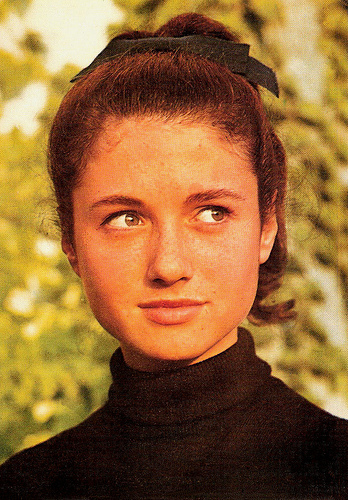
French postcard by E.D.U.G., no. 399. Photo: G. Neucevelle.
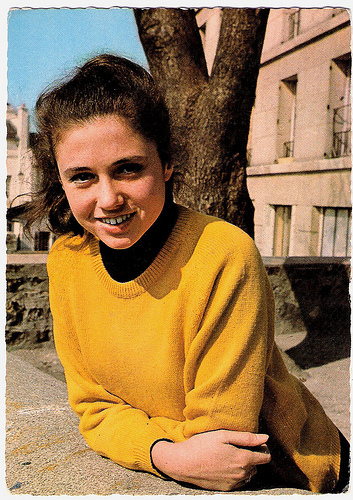
French postcard by E.D.U.G., no. 398. Photo: G. Neucevelle / Disques Festival.
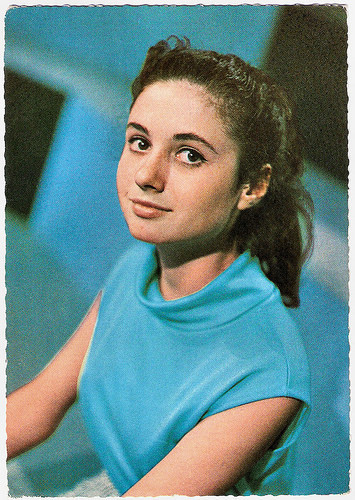
French postcard by PSG, no. 1029. Photo: Gérard Neuvecelle.
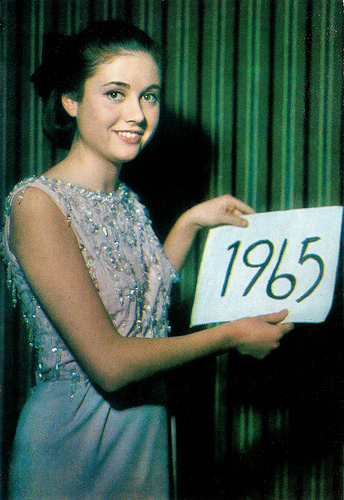
Spanish postcard by Postal Oscarcolor, no. 285.
First Ever Victory
Gigliola Cinquetti was born in Verona, Italy in 1947.
In the autumn of 1963 she appeared at the Festival di Castrocaro and won with the song Le strade di notte (The Streets of the Night). In 1964, she won the Festival di Sanremo singing Non ho l'età (I'm Not Old Enough), with music composed by Nicola Salerno and lyrics by Mario Panzeri.
Her victory enabled her to represent Italy in the Eurovision Song Contest 1964 with the same song, and she went on to claim her country's first ever victory in the event. Her song became an international success, even entering the UK Singles Chart, traditionally unusual for Italian material. Non ho l'età sold over three million copies, and was awarded a platinum disc in August 1964.
That year she also appeared in the film comedy Canzoni bulli e pupe/Lyrics, Guys and Dolls (Carlo Infascelli, 1964) with the comedians Franco Franchi and Ciccio Ingrassia playing an adman and a mad scientist who have found a way to interfere with TV broadcasts in order to promote a plumcake. The following year she appeared in another musicarello (Italian musical with a lot of contemporary hit songs), Questi pazzi, pazzi italiani/These crazy, crazy Italians (Tullio Piacentini, 1965) also with Petula Clark .
In 1966, she recorded Dio, come ti amo (God, How I Love You), which became another worldwide hit. She also continued to appear in the cinema. She played a small part in the family comedy Testa di rapa/Blockhead (Giancarlo Zagni, 1966) featuring Folco Lulli, and she had the lead in the romantic drama Dio, come ti amo!/How Do I Love You? (Miguel Iglesias, 1966), an Italian-Spanish coproduction co-starring Mark Damon.
On TV she appeared in such musical comedies as Addio giovinezza!/Goodbye youth! (Antonello Falqui, 1968) with Nino Castelnuovo. In the cinema she starred with Little Tony in Il professor Matusa e i suoi hippies/Professor Matusa and his Hippies (Luigi de Maria, 1968). Among her hit songs from these years are Piccola Cittá (1967), La Pioggia (1969), Amarti e Poi Morire, Le Bateau Mouche (1971), and Je Suis Timide (1972).
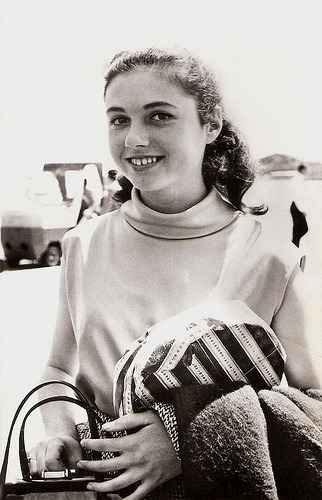
Dutch postcard by Gebr. Spanjersberg N.V., Rotterdam, no. 1212.
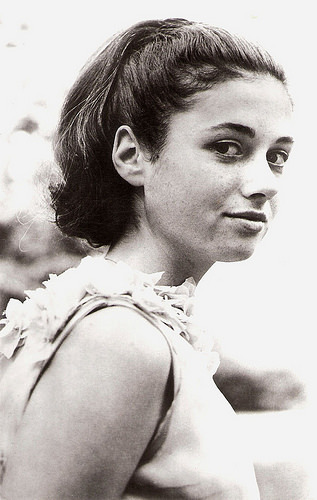
Dutch postcard by Gebr. Spanjersberg N.V., Rotterdam, no. 1200.
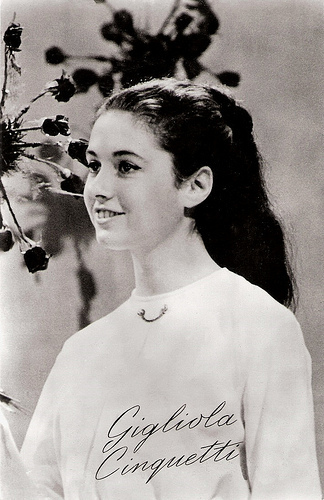
Dutch postcard by Takken, Utrecht, no. AX 5908.
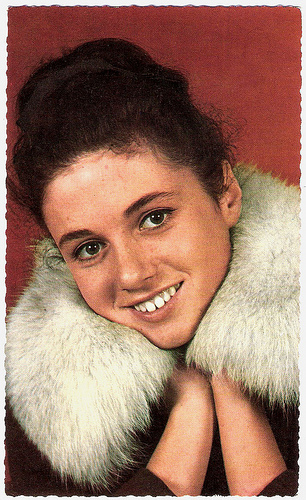
French postcard by Publistar, Marseille, no. 1030. Photo: Giancolombo / Disques Festival.
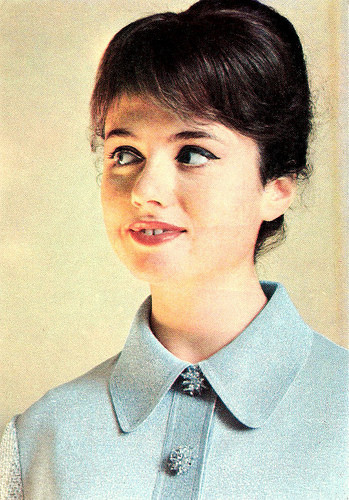
Italian postcard by CGD.
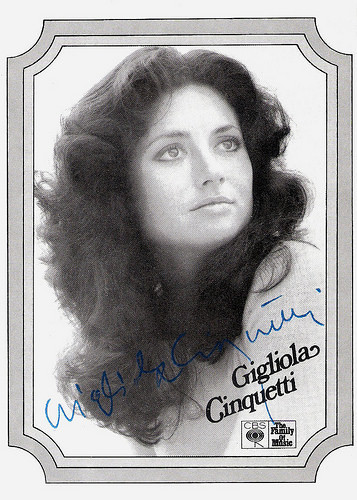
German autograph card by CBS.
Political Firestorm
Gigliola Cinquetti returned to the Eurovision Song Contest in 1974. She performed the song Sì (Yes), again representing Italy. She finished second behind Waterloo, sung by Sweden's ABBA . At All Music , Dave Thompson writes that she ran into a political firestorm in her homeland: “Italy was about to go to the polls for a referendum on the legalization of divorce. It was feared that the song's title, translating as Yes, would be construed as a commentary upon the debate and might even act as a subliminal message to voters.”
The live telecast of her song was even banned in her home country by Italy’s national broadcaster RAI. The song remained censored on most Italian state TV and radio stations for over a month. An English language version of the song, Go (Before You Break My Heart), reached number 8 in the UK Singles Chart in June 1974.
One of her other songs, Alle Porte del Sole (1973), was re-recorded in English as Door of the Sun and Italian by Al Martino, two years after its initial release. It reached #17 on Billboard's Hot 100 in the United States. Cinquetti's own English version of the song was released as a single by CBS Records in August 1974, with her original 1973 Italian version on the B-side.
Cinquetti went on to co-host the Eurovision Song Contest 1991 with Toto Cutugno, who had brought the event to Italy with his victory in Zagreb the previous year - the country's first win in the contest since her own twenty-six years earlier. During her career she had more than 10 Top 20 hits in Italy.
In the 1990s she became a professional journalist and TV presenter. She is a supporter of the center-left Italian Democratic Party (PD) led by Walter Veltroni. In 1999 she played a small role in the Italian sit-com Commesse/Shopgirls (Giorgio Capitani, 1999). Her last film role was a small part as a mother superior in the adventure film I cavalieri che fecero l'impresa/The Knights Who Made the Enterprise (Pupi Avati, 2001) starring Raoul Bova, Edward Furlong and Thomas Kretschman.
From 1979 on, Gigliola Cinquetti has been married to Luciano Teodori and they have two sons: Giovanni and Costantino. Nowadays, she hosts the current affairs programme Italia Rai on RAI International, and remains a well-known and much-loved public figure in Italy.
Gigliola Cinquetti sings Non ho l'età at the Eurovision Song Contest 1964. Source: 1947dave (YouTube).
Gigliola Cinquetti sings Anema e Core in the film Dio, come ti amo!/How Do I Love You? (1966). Source: Odaizon (YouTube).
Gigliola Cinquetti sings Legendado in Dio Come Te Amo (1966). Source: Claudio Santana (YiouTube).
Gigliola Cinquetti sings Si at the Eurovision Song Contest 1974. Source: escbelgium3 | 1956 - 1979 (YouTube).
Sources: Dave Thompson (All Music Guide), Wikipedia and .

French postcard by E.D.U.G., no. 399. Photo: G. Neucevelle.

French postcard by E.D.U.G., no. 398. Photo: G. Neucevelle / Disques Festival.

French postcard by PSG, no. 1029. Photo: Gérard Neuvecelle.

Spanish postcard by Postal Oscarcolor, no. 285.
First Ever Victory
Gigliola Cinquetti was born in Verona, Italy in 1947.
In the autumn of 1963 she appeared at the Festival di Castrocaro and won with the song Le strade di notte (The Streets of the Night). In 1964, she won the Festival di Sanremo singing Non ho l'età (I'm Not Old Enough), with music composed by Nicola Salerno and lyrics by Mario Panzeri.
Her victory enabled her to represent Italy in the Eurovision Song Contest 1964 with the same song, and she went on to claim her country's first ever victory in the event. Her song became an international success, even entering the UK Singles Chart, traditionally unusual for Italian material. Non ho l'età sold over three million copies, and was awarded a platinum disc in August 1964.
That year she also appeared in the film comedy Canzoni bulli e pupe/Lyrics, Guys and Dolls (Carlo Infascelli, 1964) with the comedians Franco Franchi and Ciccio Ingrassia playing an adman and a mad scientist who have found a way to interfere with TV broadcasts in order to promote a plumcake. The following year she appeared in another musicarello (Italian musical with a lot of contemporary hit songs), Questi pazzi, pazzi italiani/These crazy, crazy Italians (Tullio Piacentini, 1965) also with Petula Clark .
In 1966, she recorded Dio, come ti amo (God, How I Love You), which became another worldwide hit. She also continued to appear in the cinema. She played a small part in the family comedy Testa di rapa/Blockhead (Giancarlo Zagni, 1966) featuring Folco Lulli, and she had the lead in the romantic drama Dio, come ti amo!/How Do I Love You? (Miguel Iglesias, 1966), an Italian-Spanish coproduction co-starring Mark Damon.
On TV she appeared in such musical comedies as Addio giovinezza!/Goodbye youth! (Antonello Falqui, 1968) with Nino Castelnuovo. In the cinema she starred with Little Tony in Il professor Matusa e i suoi hippies/Professor Matusa and his Hippies (Luigi de Maria, 1968). Among her hit songs from these years are Piccola Cittá (1967), La Pioggia (1969), Amarti e Poi Morire, Le Bateau Mouche (1971), and Je Suis Timide (1972).

Dutch postcard by Gebr. Spanjersberg N.V., Rotterdam, no. 1212.

Dutch postcard by Gebr. Spanjersberg N.V., Rotterdam, no. 1200.

Dutch postcard by Takken, Utrecht, no. AX 5908.

French postcard by Publistar, Marseille, no. 1030. Photo: Giancolombo / Disques Festival.

Italian postcard by CGD.

German autograph card by CBS.
Political Firestorm
Gigliola Cinquetti returned to the Eurovision Song Contest in 1974. She performed the song Sì (Yes), again representing Italy. She finished second behind Waterloo, sung by Sweden's ABBA . At All Music , Dave Thompson writes that she ran into a political firestorm in her homeland: “Italy was about to go to the polls for a referendum on the legalization of divorce. It was feared that the song's title, translating as Yes, would be construed as a commentary upon the debate and might even act as a subliminal message to voters.”
The live telecast of her song was even banned in her home country by Italy’s national broadcaster RAI. The song remained censored on most Italian state TV and radio stations for over a month. An English language version of the song, Go (Before You Break My Heart), reached number 8 in the UK Singles Chart in June 1974.
One of her other songs, Alle Porte del Sole (1973), was re-recorded in English as Door of the Sun and Italian by Al Martino, two years after its initial release. It reached #17 on Billboard's Hot 100 in the United States. Cinquetti's own English version of the song was released as a single by CBS Records in August 1974, with her original 1973 Italian version on the B-side.
Cinquetti went on to co-host the Eurovision Song Contest 1991 with Toto Cutugno, who had brought the event to Italy with his victory in Zagreb the previous year - the country's first win in the contest since her own twenty-six years earlier. During her career she had more than 10 Top 20 hits in Italy.
In the 1990s she became a professional journalist and TV presenter. She is a supporter of the center-left Italian Democratic Party (PD) led by Walter Veltroni. In 1999 she played a small role in the Italian sit-com Commesse/Shopgirls (Giorgio Capitani, 1999). Her last film role was a small part as a mother superior in the adventure film I cavalieri che fecero l'impresa/The Knights Who Made the Enterprise (Pupi Avati, 2001) starring Raoul Bova, Edward Furlong and Thomas Kretschman.
From 1979 on, Gigliola Cinquetti has been married to Luciano Teodori and they have two sons: Giovanni and Costantino. Nowadays, she hosts the current affairs programme Italia Rai on RAI International, and remains a well-known and much-loved public figure in Italy.
Gigliola Cinquetti sings Non ho l'età at the Eurovision Song Contest 1964. Source: 1947dave (YouTube).
Gigliola Cinquetti sings Anema e Core in the film Dio, come ti amo!/How Do I Love You? (1966). Source: Odaizon (YouTube).
Gigliola Cinquetti sings Legendado in Dio Come Te Amo (1966). Source: Claudio Santana (YiouTube).
Gigliola Cinquetti sings Si at the Eurovision Song Contest 1974. Source: escbelgium3 | 1956 - 1979 (YouTube).
Sources: Dave Thompson (All Music Guide), Wikipedia and .
Published on June 17, 2016 22:00
June 16, 2016
EFSP's Dazzling Dozen: Pathé shorts
Today is the final day of the Domitor 2016 conference in Stockholm. This international conference for film historians bulks of interesting lectures, panels, round tables and screenings, all on the early cinema. The film programme includes early shorts made before World War I by the French studio Pathé Frères. So especially for our favourite film historian who does a presentation today in Stockholm, EFSP presents 12 dazzling but very old postcards of early Pathé shorts.
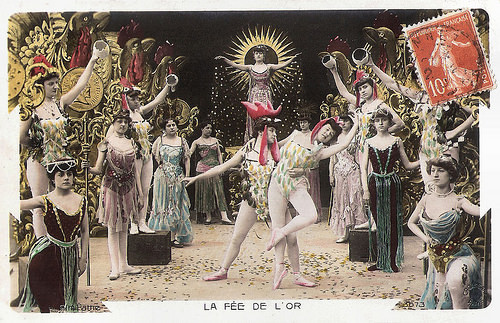
French postcard by Croissant, Paris, no. 3573. Photo: Film Pathé.
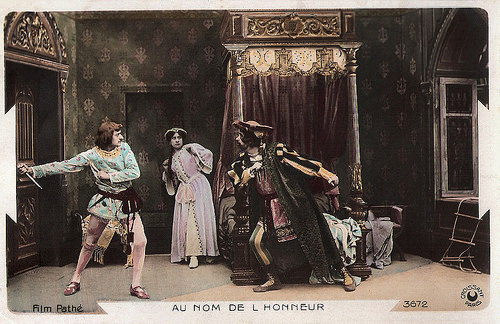
French postcard by Croissant, Paris, no. 3672. Photo: Film Pathé. Publicity still for Un drame à Venise/Venetian Tragedy (Lucien Nonguet, 1906). Sent by mail in 1917.
In this early Pathé Frères production, one of the rich palaces of Venice is the setting for a drama of smouldering love and hate. In the Middle Ages, an important lord is not loved by his wife. Despite the sumptuous wealth her husband surrounds her with, the noble dame can only think about a young and handsome Romeo. The lover is surprised by the husband, who kills him and Romeo ends in a canal. The noble lady escapes her death when her husband is stopped by her miraculous beauty... The film is partly in colour.
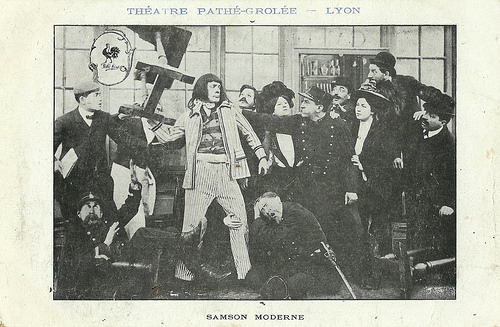
French postcard by Théâtre Pathé Grolée, Lyon. Photo: Pathé Frères. Publicity still for Samson moderne (N.N., 1908).
On the fairground an unknown young man manages to conquer the wrestling champion. When after a series of adventures he is imprisoned he breaks down the walls like a modern Samson. Returned home his wife celebrates him with wine but is jealous of his force, so like a modern Delila she cuts his hair off in his sleep. Awakened, the man has lost his hair and his strength.

French postcard by Théâtre Pathé Grolée, Lyon. Photo: Pathé Frères. Publicity still for La légende de Polichinelle (Albert Capellani, 1907). With Max Linder as Polichinelle.
Polichinelle is an automaton in love with a cute doll in the same shop. When the doll is sold, a fairy helps Polichinelle following her and after a series of wild adventures he arrives at the house of the buyer just in time to save the doll from being burned.
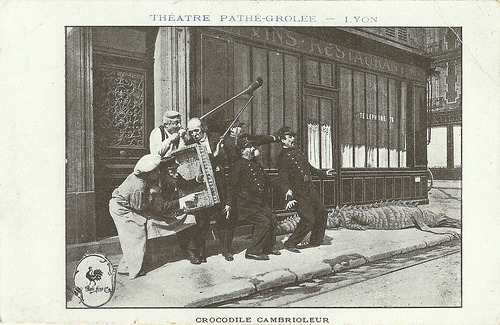
French postcard by Théâtre Pathé Grolée, Lyon. Photo: Pathé frères. Publicity still for Un crocodile cambrioleur (N.N., 1908).
Two burglars are interrupted in their job, so one hides underneath a crocodile skin. The old professor sees the dead animal moving and alarmed he leaves to find his gun. The 'reptile' flees but is hunted by the professor and his shotgun. An ever growing multitude follows the crocodile on the street. Finally the thief mounts a pipe and frightens a family taking tea, profiting from their flight to steal valuable objects, and exiting the same way as he came. Meanwhile, the mass outside shows up while our man takes off his skin. The professor shoots and all are surprised when they find just the skin and the thief gone.
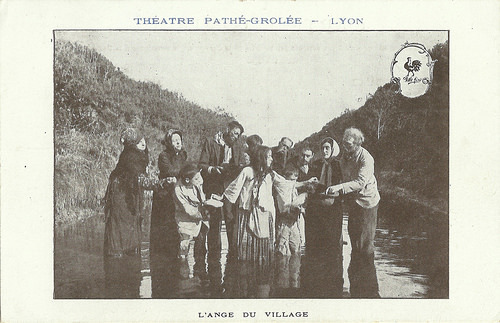
French postcard by Théâtre Pathé Grolée, Lyon. Photo: Pathé Frères. Publicity still for L'ange du village (N.N., 1908).
A young girl who begs for money to help her deadly sick mother, witnesses her mother's death and goes berserk. Everywhere she goes she sees beggars whom she gives money: even in a river. She wanders fields and woods. Suddenly she sees her mother with her arms spread... and falls dead on the road.
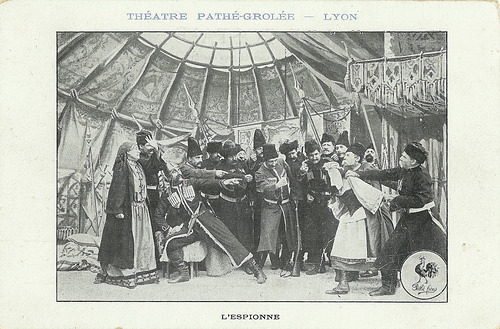
French postcard by Théâtre Pathé Grolée, Lyon.Photo: Pathé Frères. Publicity still for L'Espionne (N.N., 1906). With Louis Pagliéri.
Vera, daughter of a Cossack loves a young tartar who is the enemy of her father. She betrays her father to save the life of her lover, but loses her own life instead.
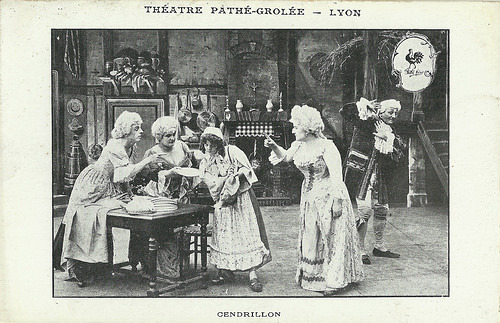
French postcard by Théâtre Pathé Grolée, Lyon. Photo: Pathé Frères. Publicity still for the fairy tale film Cendrillon, ou la Pantoufle Merveilleuse/Cinderella, or the Marvellous Slipper (Albert Capellani, 1907).
Louise Lagrange played Cinderella in this production by Ferdinand Zecca for Pathé Frères. It was adapted from the Charles Perrault fairy tale.
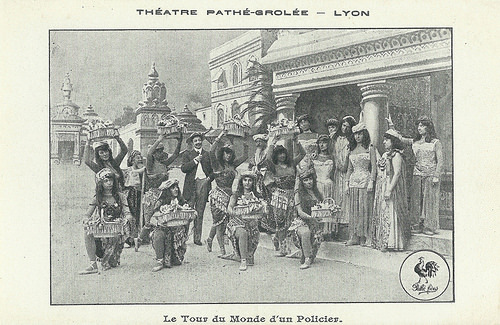
French postcard by Théâtre Pathé Grolée, Lyon. Photo: Pathé Frères. Publicity still for Le tour du monde d'un policier (Charles Lépine, 1906). Special effects by Segundo de Chomón.
Georges Vinter plays a police detective who has many adventures as he travels to Suez, Bombay, Yokohama, and the U.S.
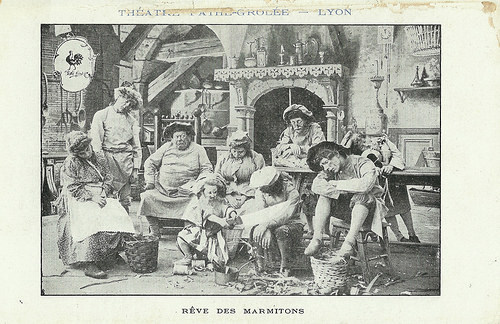
French postcard by Théâtre Pathé Grolée, Lyon. Photo: Pathé Frères. Publicity still for Rêve des marmitons (Segundo de Chomón, 1905). Special effects by Segundo de Chomón.
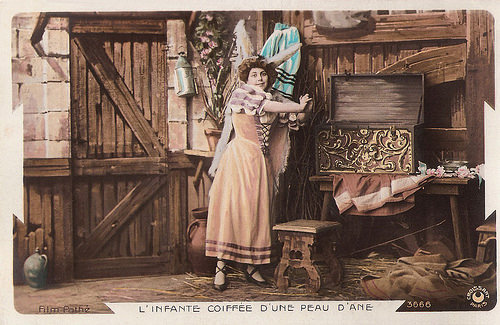
French postcard by Croissant, Paris, no. 3666. Photo: Film Pathé. Publicity still for Peau d'âne/Donkey Skin (Albert Capellani, 1908). Caption: L'infante coiffée d'une peau d'âne (The princess wears a donkey skin).
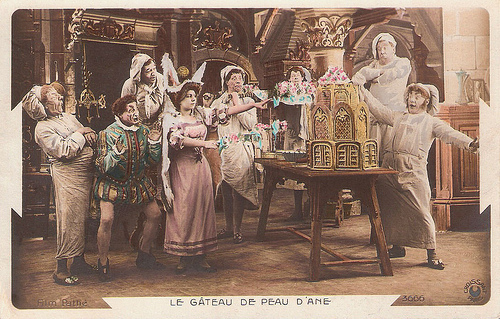
French postcard by Croissant, Paris, no. 3666. Photo: Film Pathé. Publicity still for Peau d'âne/Donkey Skin (Albert Capellani, 1908). Caption: Le Gateau de Peau d'ane (The Cake of Donkey Skin).
The early Pathé production Peau d'ane/Donkey Skin (1908, Albert Capellani) was based on a fairytale by Charles Perrault (1697). The actors are unknown.
Source: Fondation Jerome Seydoux Pathé (French).
This is a post for Postcard Friendship Friday, hosted by Beth at the The Best Hearts are Crunchy. You can visit her by clicking on the button below.


French postcard by Croissant, Paris, no. 3573. Photo: Film Pathé.

French postcard by Croissant, Paris, no. 3672. Photo: Film Pathé. Publicity still for Un drame à Venise/Venetian Tragedy (Lucien Nonguet, 1906). Sent by mail in 1917.
In this early Pathé Frères production, one of the rich palaces of Venice is the setting for a drama of smouldering love and hate. In the Middle Ages, an important lord is not loved by his wife. Despite the sumptuous wealth her husband surrounds her with, the noble dame can only think about a young and handsome Romeo. The lover is surprised by the husband, who kills him and Romeo ends in a canal. The noble lady escapes her death when her husband is stopped by her miraculous beauty... The film is partly in colour.

French postcard by Théâtre Pathé Grolée, Lyon. Photo: Pathé Frères. Publicity still for Samson moderne (N.N., 1908).
On the fairground an unknown young man manages to conquer the wrestling champion. When after a series of adventures he is imprisoned he breaks down the walls like a modern Samson. Returned home his wife celebrates him with wine but is jealous of his force, so like a modern Delila she cuts his hair off in his sleep. Awakened, the man has lost his hair and his strength.

French postcard by Théâtre Pathé Grolée, Lyon. Photo: Pathé Frères. Publicity still for La légende de Polichinelle (Albert Capellani, 1907). With Max Linder as Polichinelle.
Polichinelle is an automaton in love with a cute doll in the same shop. When the doll is sold, a fairy helps Polichinelle following her and after a series of wild adventures he arrives at the house of the buyer just in time to save the doll from being burned.

French postcard by Théâtre Pathé Grolée, Lyon. Photo: Pathé frères. Publicity still for Un crocodile cambrioleur (N.N., 1908).
Two burglars are interrupted in their job, so one hides underneath a crocodile skin. The old professor sees the dead animal moving and alarmed he leaves to find his gun. The 'reptile' flees but is hunted by the professor and his shotgun. An ever growing multitude follows the crocodile on the street. Finally the thief mounts a pipe and frightens a family taking tea, profiting from their flight to steal valuable objects, and exiting the same way as he came. Meanwhile, the mass outside shows up while our man takes off his skin. The professor shoots and all are surprised when they find just the skin and the thief gone.

French postcard by Théâtre Pathé Grolée, Lyon. Photo: Pathé Frères. Publicity still for L'ange du village (N.N., 1908).
A young girl who begs for money to help her deadly sick mother, witnesses her mother's death and goes berserk. Everywhere she goes she sees beggars whom she gives money: even in a river. She wanders fields and woods. Suddenly she sees her mother with her arms spread... and falls dead on the road.

French postcard by Théâtre Pathé Grolée, Lyon.Photo: Pathé Frères. Publicity still for L'Espionne (N.N., 1906). With Louis Pagliéri.
Vera, daughter of a Cossack loves a young tartar who is the enemy of her father. She betrays her father to save the life of her lover, but loses her own life instead.

French postcard by Théâtre Pathé Grolée, Lyon. Photo: Pathé Frères. Publicity still for the fairy tale film Cendrillon, ou la Pantoufle Merveilleuse/Cinderella, or the Marvellous Slipper (Albert Capellani, 1907).
Louise Lagrange played Cinderella in this production by Ferdinand Zecca for Pathé Frères. It was adapted from the Charles Perrault fairy tale.

French postcard by Théâtre Pathé Grolée, Lyon. Photo: Pathé Frères. Publicity still for Le tour du monde d'un policier (Charles Lépine, 1906). Special effects by Segundo de Chomón.
Georges Vinter plays a police detective who has many adventures as he travels to Suez, Bombay, Yokohama, and the U.S.

French postcard by Théâtre Pathé Grolée, Lyon. Photo: Pathé Frères. Publicity still for Rêve des marmitons (Segundo de Chomón, 1905). Special effects by Segundo de Chomón.

French postcard by Croissant, Paris, no. 3666. Photo: Film Pathé. Publicity still for Peau d'âne/Donkey Skin (Albert Capellani, 1908). Caption: L'infante coiffée d'une peau d'âne (The princess wears a donkey skin).

French postcard by Croissant, Paris, no. 3666. Photo: Film Pathé. Publicity still for Peau d'âne/Donkey Skin (Albert Capellani, 1908). Caption: Le Gateau de Peau d'ane (The Cake of Donkey Skin).
The early Pathé production Peau d'ane/Donkey Skin (1908, Albert Capellani) was based on a fairytale by Charles Perrault (1697). The actors are unknown.
Source: Fondation Jerome Seydoux Pathé (French).
This is a post for Postcard Friendship Friday, hosted by Beth at the The Best Hearts are Crunchy. You can visit her by clicking on the button below.

Published on June 16, 2016 22:00
June 15, 2016
Claude Hulbert
Popular stage and screen comedian Claude Hulbert (1900-1964) starred in several minor British films of the 1930s. He was called 'the king of the posh idiots'. Hulbert also scripted a few films, composed some soundtracks, and was a successful radio broadcaster.
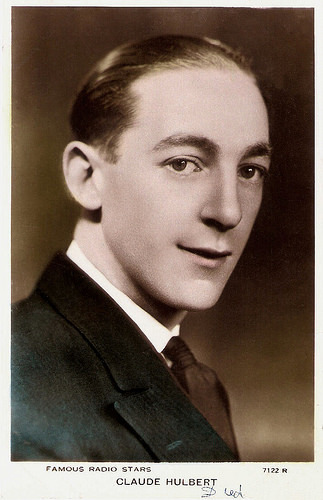
British postcard in the Famous Radio Stars series by Valentine's, no. 7122 M.
Silly-ass
Claude Noel Hulbert was born in London in 1900 as the son of a doctor. Like his elder brother Jack Hulbert he studied at Cambridge University and was a member of the Footlights comedy club, but didn't take a degree.
He made his professional debut in 1920 and joined his sister-in-law Cicely Courtneidge at the music halls. In the 1920s he started to perform on stage supporting the Aldwych farceurs. He had a hit with the George and Ira Gershwin musical Primrose in 1924 and spent the rest of the decade in musical comedy such as in another Gershwin musical Oh Kay! (1927).
Apart from an uncredited part in the silent Hitchcock film Champagne (Alfred Hitchcock, 1928), Hulbert’s film career really began in the sound era. From 1930 on, he largely abandoned the stage to concentrate on his film and broadcasting career. His screen roles as a silly-ass got bigger by the years.
Hulbert began by supporting Ralph Lynn in Aldwych comedies before he got his first lead in the minor comedy Their Night Out (1933), which costarred Renee Houston and Binnie Barnes. In that year, Hulbert did various films for British International Pictures, often as co-star.
He had the male lead in the comedy Big Business (Cyril Gardner, 1934), co-scripted by Gardner and Hulbert, and produced by Warner and First National. Occasionally Hulbert worked with his brother. In 1934, he wrote the song My Hat’s on the Side of My Head for Jack Hulbert ’s song and dance comedy Jack Ahoy!
In 1935 Claude Hulbert had a supporting role in Bulldog Jack (Walter Forde 1935) starring his brother Jack and Fay Wray. This Gaumont International production was a crime film with scenes at the British Museum and the London Underground. And in 1940 Claude would write the song Conga for Jack Hulbert’s film Under Your Hat (Maurice Elvey, 1940).
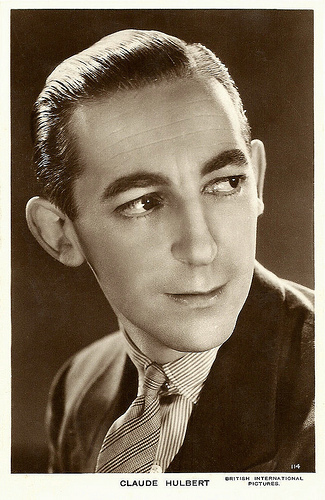
British postcard, no. 114. Photo: British International Pictures.
Upperclass Twit
David Absolom observes: "Claude Hulbert had a face for comedy - long, wide eyed, and jug eared. That coupled with his sweet demeanour made him the king of the posh idiots." In 1935 he played the lead of Henry Pennyfeather in Hello Sweetheart (Monty Banks, 1935), a comedy co-starring Gregory Ratoff and Jane Carr.
It was a comedy about a naive farmer who looses all to perfidious grifters who convince him to invest in their film and halfway dump him. The farmer though manages to finish the film himself, turning it into a comedy and creating a big success. It is said to have been his most successful solo film of the mid-1930s, but it is now sadly a lost film.
Wikipedia writes: ‘like most of Hulbert's starring comedies, however, its ambition was strictly small-scale; it seemed that British studios simply didn't see him as a major star.’ His budgets were always limited too, reducing most of his output to a kind of B-movies.
Still, Hulbert had interesting partners in his films, such as Douglas Fairbanks jr. and Laura LaPlante in Man of the Moment (Monty Banks, 1935). Hulbert’s film career got a boost with Wolf's Clothing (Andrew Marton, 1936), in which he starred as the upper-clas twit Ambrose Girling who is a lookalike of a notorious assassin. Hulbert’s female costar was Lilli Palmer , in one of her first roles in Britain.
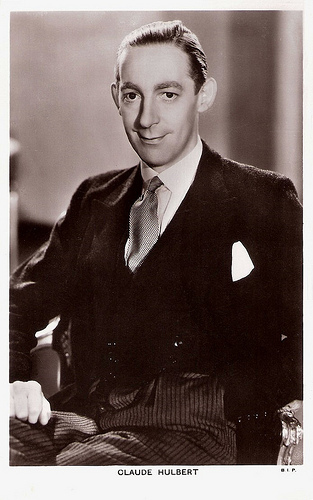
British postcard in the Picturegoer Series, no. 878. Photo: British International Pictures (B.I.P.).
Bumbling Bridegroom
After some minor parts in comedies, Claude Hulbert had a long series of leads in the late 1930s while he also started to expand his genre repertory, such as the adventure film Hail and Farewell (Ralph Ince, 1936) about sailors on leave, and the crime story The Vulture (Ralph Ince, 1937) about a detective capturing jewel thieves in Chinatown. However, even these films had comical aspects.
Most other leads of Hulbert were in comedies, like Olympic Honeymoon/Honeymoon-Merry-Go-Round (Alfred J. Goulding, 1940), ‘where he played a bumbling bridegroom who unintentionally becomes an ice-hockey star' ( Wikipedia ). After the war broke out, Hulbert played in war comedies too, like Sailors Three (Walter Forde, 1940), about three sailors who accidentally get aboard a nazi ship.
In 1941 Hulbert became a popular side-kick for comic actor Will Hay in The Ghost of St Michael's (Marcel Varnel, 1941) in which Hay hunts a killer ghost in Scotland. It took two years for Hulbert’s subsequent role as co-star in the crime story The Dummy Talks (Oswald Mitchell, 1943), starring debuting actor Jack Warner.
In the same year Hulbert was Hay’s sidekick again in the dark comedy My Learned Friend (Basil Dearden, Will Hay, 1943), about a seedy lawyer threatened by a vengeful escaped convict. In the late 1940s Hulbert continued to play in film but his appearances became scarcer and smaller. As a film actor Claude Hulbert was less of a leading man than his brother. Wikipedia states: "His films were, at best, modest and moderate, sadly lacking in budget, ambition and spark."
Hulbert resumed his stage work, scoring notable hits in the Hulbert Follies and Panama Hattie. He also excelled as a radio broadcaster, often in partnership with his wife, actress Enid Trevor, whom he had married in 1924. In 1964, Claude Hulbert died in a hospital in Sydney, during a world cruise taken for the sake of his health.
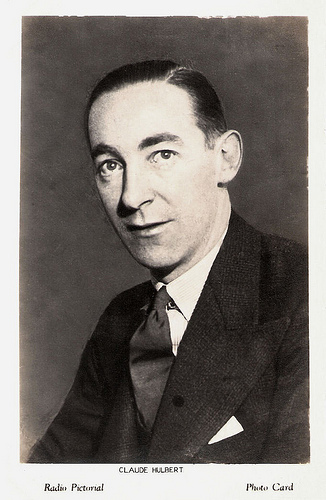
British photo card by Radio Pictorial.
Sources: David Absalom (British Pictures), Wikipedia and .

British postcard in the Famous Radio Stars series by Valentine's, no. 7122 M.
Silly-ass
Claude Noel Hulbert was born in London in 1900 as the son of a doctor. Like his elder brother Jack Hulbert he studied at Cambridge University and was a member of the Footlights comedy club, but didn't take a degree.
He made his professional debut in 1920 and joined his sister-in-law Cicely Courtneidge at the music halls. In the 1920s he started to perform on stage supporting the Aldwych farceurs. He had a hit with the George and Ira Gershwin musical Primrose in 1924 and spent the rest of the decade in musical comedy such as in another Gershwin musical Oh Kay! (1927).
Apart from an uncredited part in the silent Hitchcock film Champagne (Alfred Hitchcock, 1928), Hulbert’s film career really began in the sound era. From 1930 on, he largely abandoned the stage to concentrate on his film and broadcasting career. His screen roles as a silly-ass got bigger by the years.
Hulbert began by supporting Ralph Lynn in Aldwych comedies before he got his first lead in the minor comedy Their Night Out (1933), which costarred Renee Houston and Binnie Barnes. In that year, Hulbert did various films for British International Pictures, often as co-star.
He had the male lead in the comedy Big Business (Cyril Gardner, 1934), co-scripted by Gardner and Hulbert, and produced by Warner and First National. Occasionally Hulbert worked with his brother. In 1934, he wrote the song My Hat’s on the Side of My Head for Jack Hulbert ’s song and dance comedy Jack Ahoy!
In 1935 Claude Hulbert had a supporting role in Bulldog Jack (Walter Forde 1935) starring his brother Jack and Fay Wray. This Gaumont International production was a crime film with scenes at the British Museum and the London Underground. And in 1940 Claude would write the song Conga for Jack Hulbert’s film Under Your Hat (Maurice Elvey, 1940).

British postcard, no. 114. Photo: British International Pictures.
Upperclass Twit
David Absolom observes: "Claude Hulbert had a face for comedy - long, wide eyed, and jug eared. That coupled with his sweet demeanour made him the king of the posh idiots." In 1935 he played the lead of Henry Pennyfeather in Hello Sweetheart (Monty Banks, 1935), a comedy co-starring Gregory Ratoff and Jane Carr.
It was a comedy about a naive farmer who looses all to perfidious grifters who convince him to invest in their film and halfway dump him. The farmer though manages to finish the film himself, turning it into a comedy and creating a big success. It is said to have been his most successful solo film of the mid-1930s, but it is now sadly a lost film.
Wikipedia writes: ‘like most of Hulbert's starring comedies, however, its ambition was strictly small-scale; it seemed that British studios simply didn't see him as a major star.’ His budgets were always limited too, reducing most of his output to a kind of B-movies.
Still, Hulbert had interesting partners in his films, such as Douglas Fairbanks jr. and Laura LaPlante in Man of the Moment (Monty Banks, 1935). Hulbert’s film career got a boost with Wolf's Clothing (Andrew Marton, 1936), in which he starred as the upper-clas twit Ambrose Girling who is a lookalike of a notorious assassin. Hulbert’s female costar was Lilli Palmer , in one of her first roles in Britain.

British postcard in the Picturegoer Series, no. 878. Photo: British International Pictures (B.I.P.).
Bumbling Bridegroom
After some minor parts in comedies, Claude Hulbert had a long series of leads in the late 1930s while he also started to expand his genre repertory, such as the adventure film Hail and Farewell (Ralph Ince, 1936) about sailors on leave, and the crime story The Vulture (Ralph Ince, 1937) about a detective capturing jewel thieves in Chinatown. However, even these films had comical aspects.
Most other leads of Hulbert were in comedies, like Olympic Honeymoon/Honeymoon-Merry-Go-Round (Alfred J. Goulding, 1940), ‘where he played a bumbling bridegroom who unintentionally becomes an ice-hockey star' ( Wikipedia ). After the war broke out, Hulbert played in war comedies too, like Sailors Three (Walter Forde, 1940), about three sailors who accidentally get aboard a nazi ship.
In 1941 Hulbert became a popular side-kick for comic actor Will Hay in The Ghost of St Michael's (Marcel Varnel, 1941) in which Hay hunts a killer ghost in Scotland. It took two years for Hulbert’s subsequent role as co-star in the crime story The Dummy Talks (Oswald Mitchell, 1943), starring debuting actor Jack Warner.
In the same year Hulbert was Hay’s sidekick again in the dark comedy My Learned Friend (Basil Dearden, Will Hay, 1943), about a seedy lawyer threatened by a vengeful escaped convict. In the late 1940s Hulbert continued to play in film but his appearances became scarcer and smaller. As a film actor Claude Hulbert was less of a leading man than his brother. Wikipedia states: "His films were, at best, modest and moderate, sadly lacking in budget, ambition and spark."
Hulbert resumed his stage work, scoring notable hits in the Hulbert Follies and Panama Hattie. He also excelled as a radio broadcaster, often in partnership with his wife, actress Enid Trevor, whom he had married in 1924. In 1964, Claude Hulbert died in a hospital in Sydney, during a world cruise taken for the sake of his health.

British photo card by Radio Pictorial.
Sources: David Absalom (British Pictures), Wikipedia and .
Published on June 15, 2016 22:00
June 14, 2016
La signora di tutti (1934)
Isa Miranda (1905–1982) was the only international film star produced by the Italian fascist cinema. Her breakthrough film was the drama La signora di tutti (1934), the only Italian film of the great director Max Ophüls. Isa Miranda played her future self: a glamorous and famous film star who is everybody's woman... Her haunting beauty drives men mad.
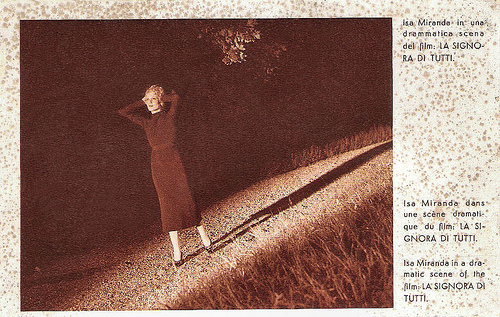
Italian postcard by Rizzoli, Milano, 1934-XII. Photo: Novella-Film. Publicity still for La signora di tutti/Everybody's Woman (Max Ophüls, 1934) with Isa Miranda .
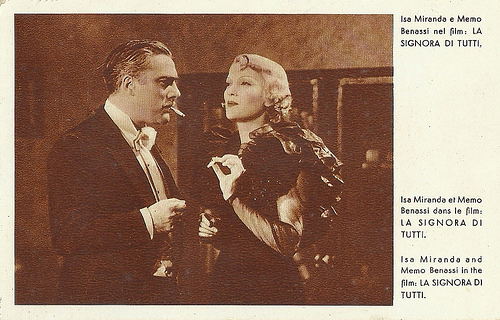
Italian postcard by Rizzoli, Milano, no. 1934-XII. Photo: Novella-Film. Publicity still for La signora di tutti/Everybody's Woman (Max Ophüls, 1934) with Isa Miranda and Memo Benassi.
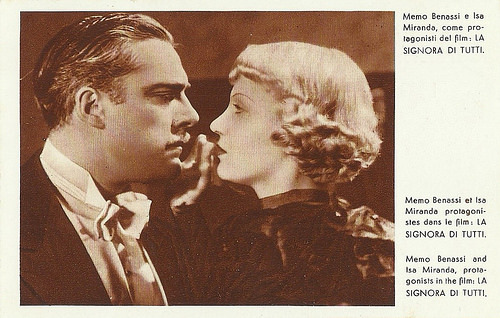
Italian postcard. by Rizzoli, Milano, 1934-XII. Photo: Novella-Film. Publicity still for La signora di tutti/Everybody's Woman (Max Ophüls, 1934) with Isa Miranda and Memo Benassi.
Attracting Men Like Moths to a Flame
Isa Miranda plays Gabriella Murge, aka famous film star Gaby Doriot, a woman who attracts men like moths, destroying themselves or others.
The film opens with a panorama of the film studio where after a frantic search her agent finds her after an attempted suicide.
On the operation table Gaby relives her life. At school, a married music teacher commits suicide, after telling her he can't live without her. Though she has done nothing, she is punished for his act by her stern father (Lamberto Picasso).
At a party of Roberto Nanni ( Enrico/ Federico Benfer ), son of wealthy businessman Leonardo Nanni, Roberto and Gaby fall in love. Roberto's handicapped mother Alma ( Tatiana Pavlova ), fearful of Gaby's reputation, eventually loves her and adopts her as aid.
While Roberto is away, Leonardo (Memo Benassi) falls in love with Gaby and takes her to the opera. Fate strikes when Leonardo declares Gaby his love in front of his villa, while a desperate Alma falls down the stairs in her wheelchair, killing herself.
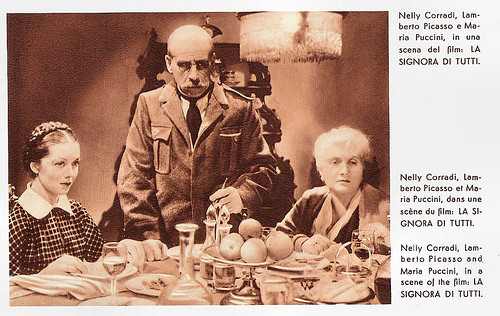
Italian postcard by Rizzoli, Milano, no. 1934-XII. Photo: Novella-Film. Publicity still for La signora di tutti/Everybody's Woman (Max Ophüls, 1934) with Nelly Corradi, Lamberto Picasso and Maria Puccini. Caption: Film prescelta per la II Biennale Cinematograficia di Venezia. (Film selected for the second Venice Film Festival).
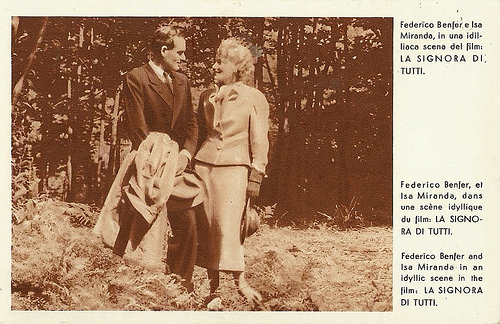
Italian postcard by Rizzoli, Milano, no. 1913 - XXII. Photo: Novella-Film. Enrico Benfer and Isa Miranda in La signora di tutti (Max Ophüls, 1934).
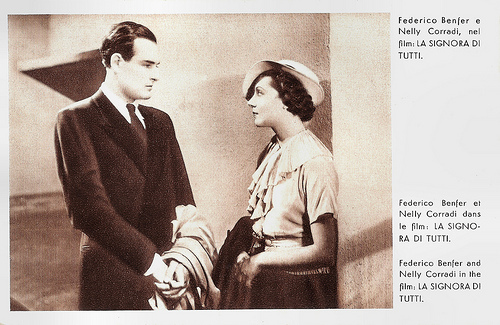
Italian postcard by Rizzoli, Milano, no. 1934 - XII. Photo: Novella-Film. Publicity still for La signora di tutti/Everybody's Woman (Max Ophüls, 1934) with Enrico Benfer and Nelly Corradi.
Haunted by the memory
After a seemingly endless trip to forget the disaster, during which Leonardo ignores business troubles, Gaby is haunted by the memory of the house when they return and flees hysterically.
Leonardo is charged with embezzlement and sentenced to prison, while Gaby becomes a big movie star. Once released, Leonardo is stunned by the multiplication of images of Gaby in a cinema foyer, during the premiere of her new film.
Chased for his poor attire, he is run over by a car. To avoid scandal, Gaby's entourage calls in Roberto to exonerate her. Gaby realises she has loved Roberto all along, but is too late, as Roberto married her more modest sister Anna (Nelly Corradi).
"We'll still be together in the film", Roberto says. Gaby realises she will stay lonesome despite wealth and stardom and commits suicide. The flashback ends with doctors declaring her death and the printing presses stopping to print her film poster.
At AllMovie , Hal Erickson writes that La Signora di Tutti can be regarded as a dress rehearsal for Ophüls' masterpiece Lola Montes (1955): "though it comes nowhere near the brilliance of that later classic (...), but Ophuls' basic premise--that fame and celebrity are ultimately hollow entities--is not to be taken lightly. The director's fabled camera techniques help smooth over some of the rougher and more ludicrous passages."
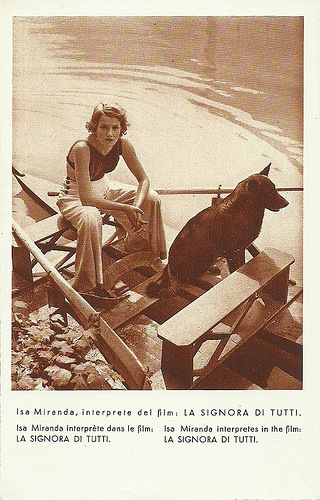
Italian postcard by Rizzoli, Milano, no. 1934-XII. Photo: Novella-Film. Publicity still for La signora di tutti/Everybody's Woman (Max Ophüls, 1934) with Isa Miranda .
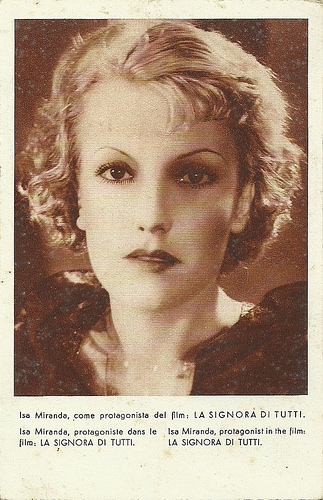
Italian postcard by Rizzoli, Milano, no. 1934-XII. Photo: Novella-Film. Publicity still for La signora di tutti/Everybody's Woman (Max Ophüls, 1934) with Isa Miranda .
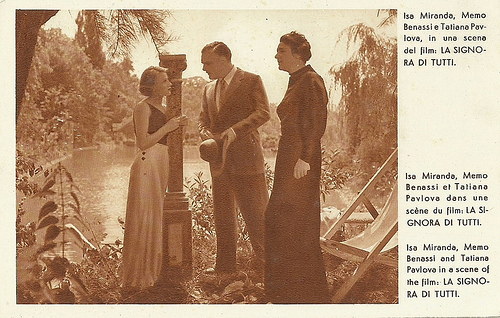
Italian postcard by Rizzoli, Milano, no. 1934 - XII. Photo: Novella-Film. Publicity still for La signora di tutti/Everybody's Woman (Max Ophüls, 1934) with Isa Miranda , Tatiana Pavlova and Memo Benassi.
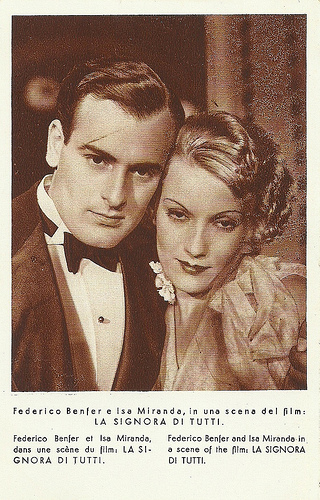
Italian postcard. by Rizzoli, Milano, 1934-XII. Photo: Novella-Film. Publicity still for La signora di tutti/Everybody's Woman (Max Ophüls, 1934) with Enrico Benfer and Isa Miranda .
Sources: Hal Erickson (AllMovie). Wikipedia (English), IMDb and the film itself.

Italian postcard by Rizzoli, Milano, 1934-XII. Photo: Novella-Film. Publicity still for La signora di tutti/Everybody's Woman (Max Ophüls, 1934) with Isa Miranda .

Italian postcard by Rizzoli, Milano, no. 1934-XII. Photo: Novella-Film. Publicity still for La signora di tutti/Everybody's Woman (Max Ophüls, 1934) with Isa Miranda and Memo Benassi.

Italian postcard. by Rizzoli, Milano, 1934-XII. Photo: Novella-Film. Publicity still for La signora di tutti/Everybody's Woman (Max Ophüls, 1934) with Isa Miranda and Memo Benassi.
Attracting Men Like Moths to a Flame
Isa Miranda plays Gabriella Murge, aka famous film star Gaby Doriot, a woman who attracts men like moths, destroying themselves or others.
The film opens with a panorama of the film studio where after a frantic search her agent finds her after an attempted suicide.
On the operation table Gaby relives her life. At school, a married music teacher commits suicide, after telling her he can't live without her. Though she has done nothing, she is punished for his act by her stern father (Lamberto Picasso).
At a party of Roberto Nanni ( Enrico/ Federico Benfer ), son of wealthy businessman Leonardo Nanni, Roberto and Gaby fall in love. Roberto's handicapped mother Alma ( Tatiana Pavlova ), fearful of Gaby's reputation, eventually loves her and adopts her as aid.
While Roberto is away, Leonardo (Memo Benassi) falls in love with Gaby and takes her to the opera. Fate strikes when Leonardo declares Gaby his love in front of his villa, while a desperate Alma falls down the stairs in her wheelchair, killing herself.

Italian postcard by Rizzoli, Milano, no. 1934-XII. Photo: Novella-Film. Publicity still for La signora di tutti/Everybody's Woman (Max Ophüls, 1934) with Nelly Corradi, Lamberto Picasso and Maria Puccini. Caption: Film prescelta per la II Biennale Cinematograficia di Venezia. (Film selected for the second Venice Film Festival).

Italian postcard by Rizzoli, Milano, no. 1913 - XXII. Photo: Novella-Film. Enrico Benfer and Isa Miranda in La signora di tutti (Max Ophüls, 1934).

Italian postcard by Rizzoli, Milano, no. 1934 - XII. Photo: Novella-Film. Publicity still for La signora di tutti/Everybody's Woman (Max Ophüls, 1934) with Enrico Benfer and Nelly Corradi.
Haunted by the memory
After a seemingly endless trip to forget the disaster, during which Leonardo ignores business troubles, Gaby is haunted by the memory of the house when they return and flees hysterically.
Leonardo is charged with embezzlement and sentenced to prison, while Gaby becomes a big movie star. Once released, Leonardo is stunned by the multiplication of images of Gaby in a cinema foyer, during the premiere of her new film.
Chased for his poor attire, he is run over by a car. To avoid scandal, Gaby's entourage calls in Roberto to exonerate her. Gaby realises she has loved Roberto all along, but is too late, as Roberto married her more modest sister Anna (Nelly Corradi).
"We'll still be together in the film", Roberto says. Gaby realises she will stay lonesome despite wealth and stardom and commits suicide. The flashback ends with doctors declaring her death and the printing presses stopping to print her film poster.
At AllMovie , Hal Erickson writes that La Signora di Tutti can be regarded as a dress rehearsal for Ophüls' masterpiece Lola Montes (1955): "though it comes nowhere near the brilliance of that later classic (...), but Ophuls' basic premise--that fame and celebrity are ultimately hollow entities--is not to be taken lightly. The director's fabled camera techniques help smooth over some of the rougher and more ludicrous passages."

Italian postcard by Rizzoli, Milano, no. 1934-XII. Photo: Novella-Film. Publicity still for La signora di tutti/Everybody's Woman (Max Ophüls, 1934) with Isa Miranda .

Italian postcard by Rizzoli, Milano, no. 1934-XII. Photo: Novella-Film. Publicity still for La signora di tutti/Everybody's Woman (Max Ophüls, 1934) with Isa Miranda .

Italian postcard by Rizzoli, Milano, no. 1934 - XII. Photo: Novella-Film. Publicity still for La signora di tutti/Everybody's Woman (Max Ophüls, 1934) with Isa Miranda , Tatiana Pavlova and Memo Benassi.

Italian postcard. by Rizzoli, Milano, 1934-XII. Photo: Novella-Film. Publicity still for La signora di tutti/Everybody's Woman (Max Ophüls, 1934) with Enrico Benfer and Isa Miranda .
Sources: Hal Erickson (AllMovie). Wikipedia (English), IMDb and the film itself.
Published on June 14, 2016 22:00
June 13, 2016
Irma Gramatica
Irma Gramatica (1867-1962) was an Italian stage and screen actress, known for her qualities but also her temper.
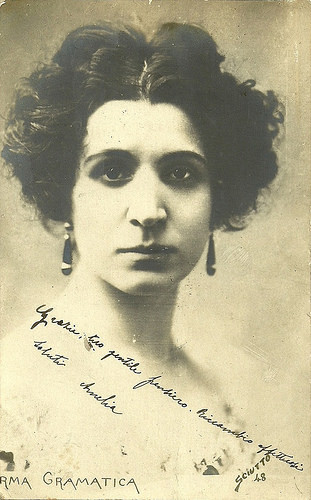
Italian postcard, no. 48. Photo: Sciutto, Genoa.
Enormous potential
Irma Gramatica, originally Maria Francesca Gramatica, was born in 1867 in Fiume, Italy (now Rijeka, Croatia). She had two sisters, both actresses as well: Emma and Anna. Though born Maria Francesca, she was called Irma from her childhood, as in Carnia, Friuli, where she was raised all Mariafrancesca’s were called Irma. She was the daughter of Domenico Gramatica and the Hungarian Cristina Bradil, respectively a prompter and a seamstress in the company of Luigi Monti.
Already at the age of five years she debuted on stage in the drama Cause ed effetti by Paolo Ferrari and immediately showed enormous potential. In her girlhood she starred alongside the great players of the time such as Cesare Rossi, Jacinta Pezzana, Flavio Andò and Eleonora Duse , supporting them in Fedora by Victorien Sardou.
She joined them in a major tour through South America, where the first symptoms of imbalance began to appear. Irma indeed tried to commit suicide by eating exotic fruit contaminated by yellow fever. The reason is unknown but seems linked to difficulties related to a great inner pain, not to sentimental origins.
At seventeen she married the actor Arnaldo Cottin and they had a son the following year. With Cottin she returned to Argentina two years after, but during the tour, the child, left back in Italy, died, and the incident led to the separation of Gramatica and her husband. While remaining in Argentina, Irma contracted meningitis from which she was saved, but anaemic and weakened by an intense nervous breakdown she suffered a deep depression, beginning to perceive her existence as an unbearable burden.
After her return to Italy, she became First Young Actress in the company of Italia Vitaliani and Vittorio Salsilli in 1892, and in 1895 First Actress, under the guidance of Napoleone Mozzidolfi and directed by Alessandro Marchetti. Under the guidance of V. Valli she perfected her outstanding temperament, suitable for a very wide repertoire.
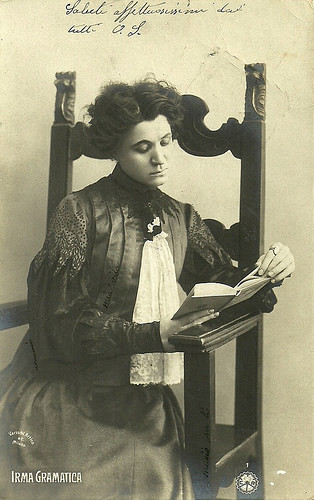
Italian postcard by T.C.R., no. 1. Photo: Varischi & Artico Co., Milano.
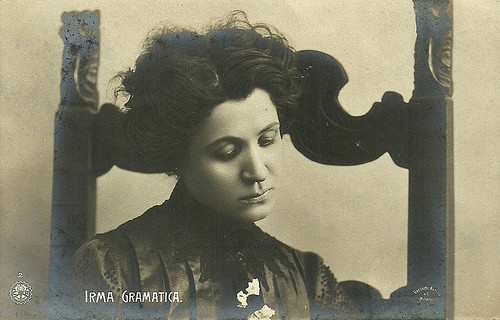
Italian postcard by T.C.R., no. 2. Photo: Varischi & Artico Co., Milano.
Grumpy and irritable character
Irma Gramatica proved to be sensitive both to the new theatre as well as the romantic authors of the 19th century. After leaving Eleonora Duse ’s company, Irma entered that of Ermete Zacconi , an actor whom the same Gramatica said "had absolute influence on the conduct of my artistic faculties."
From here began her great successes that led to the birth of the famous stage company Talli-Gramatica-Calabresi. Irma was the first Nennele in Come le foglie by Giuseppe Giacosa, Lisa in Dal tuo al mio by Giovanni Verga, Paolina in Sperduti nel buio by Roberto Bracco and especially Mila di Codro in La figlia di Jorio, which Gabriele D'Annunzio had written especially for Duse but who, because of illness could not perform it on stage.
Irma had a grumpy and irritable character, and had as she called itself a severe nature. She always tried to be approached as little as possible, admitting to detest interviews, feeling a real phobia for them and almost always rejecting them.
In the late 1930s and early 1940s she was active as film actress at the new Cinecittà studios, sometimes paired with her sister Emma as in Sissignora/Yes, Madam! (Fernando Maria Poggioli, 1941) and Sorelle Materassi/The Materassi sisters (Fernando Maria Poggioli, 1944).
Her young co-actors in those years were e.g. Laura Adani, Clara Calamai , Maria Denis, Maria Mercader and Anneliese Uhlig . Irma also played the widow Pescatore in the Italian version of Il fu Mattia Pascal (Pierre Chenal, 1937), starring Pierre Blanchar. Immediately after the war she had an important part in the refugees film Lo sconosciuto di San MarinoUnknown Men of San Marino (Michał Waszyński, 1946), for which Cesare Zavattini had written the script. Her last part was in Incantesimo tragico/Tragic Spell (Mario Sequi 1951), a period drama about a cursed treasure, set in the Maremma region.
Irma Grammatica died in Villa Giuseppina at Tavarnuzze in 1962.
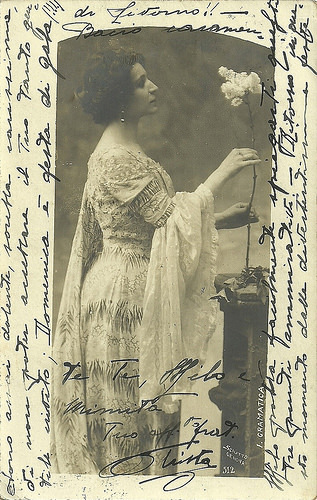
Italian postcard, no. 512. Photo: Sciutto, Genoa.
Sources: (Italian) and IMDb.

Italian postcard, no. 48. Photo: Sciutto, Genoa.
Enormous potential
Irma Gramatica, originally Maria Francesca Gramatica, was born in 1867 in Fiume, Italy (now Rijeka, Croatia). She had two sisters, both actresses as well: Emma and Anna. Though born Maria Francesca, she was called Irma from her childhood, as in Carnia, Friuli, where she was raised all Mariafrancesca’s were called Irma. She was the daughter of Domenico Gramatica and the Hungarian Cristina Bradil, respectively a prompter and a seamstress in the company of Luigi Monti.
Already at the age of five years she debuted on stage in the drama Cause ed effetti by Paolo Ferrari and immediately showed enormous potential. In her girlhood she starred alongside the great players of the time such as Cesare Rossi, Jacinta Pezzana, Flavio Andò and Eleonora Duse , supporting them in Fedora by Victorien Sardou.
She joined them in a major tour through South America, where the first symptoms of imbalance began to appear. Irma indeed tried to commit suicide by eating exotic fruit contaminated by yellow fever. The reason is unknown but seems linked to difficulties related to a great inner pain, not to sentimental origins.
At seventeen she married the actor Arnaldo Cottin and they had a son the following year. With Cottin she returned to Argentina two years after, but during the tour, the child, left back in Italy, died, and the incident led to the separation of Gramatica and her husband. While remaining in Argentina, Irma contracted meningitis from which she was saved, but anaemic and weakened by an intense nervous breakdown she suffered a deep depression, beginning to perceive her existence as an unbearable burden.
After her return to Italy, she became First Young Actress in the company of Italia Vitaliani and Vittorio Salsilli in 1892, and in 1895 First Actress, under the guidance of Napoleone Mozzidolfi and directed by Alessandro Marchetti. Under the guidance of V. Valli she perfected her outstanding temperament, suitable for a very wide repertoire.

Italian postcard by T.C.R., no. 1. Photo: Varischi & Artico Co., Milano.

Italian postcard by T.C.R., no. 2. Photo: Varischi & Artico Co., Milano.
Grumpy and irritable character
Irma Gramatica proved to be sensitive both to the new theatre as well as the romantic authors of the 19th century. After leaving Eleonora Duse ’s company, Irma entered that of Ermete Zacconi , an actor whom the same Gramatica said "had absolute influence on the conduct of my artistic faculties."
From here began her great successes that led to the birth of the famous stage company Talli-Gramatica-Calabresi. Irma was the first Nennele in Come le foglie by Giuseppe Giacosa, Lisa in Dal tuo al mio by Giovanni Verga, Paolina in Sperduti nel buio by Roberto Bracco and especially Mila di Codro in La figlia di Jorio, which Gabriele D'Annunzio had written especially for Duse but who, because of illness could not perform it on stage.
Irma had a grumpy and irritable character, and had as she called itself a severe nature. She always tried to be approached as little as possible, admitting to detest interviews, feeling a real phobia for them and almost always rejecting them.
In the late 1930s and early 1940s she was active as film actress at the new Cinecittà studios, sometimes paired with her sister Emma as in Sissignora/Yes, Madam! (Fernando Maria Poggioli, 1941) and Sorelle Materassi/The Materassi sisters (Fernando Maria Poggioli, 1944).
Her young co-actors in those years were e.g. Laura Adani, Clara Calamai , Maria Denis, Maria Mercader and Anneliese Uhlig . Irma also played the widow Pescatore in the Italian version of Il fu Mattia Pascal (Pierre Chenal, 1937), starring Pierre Blanchar. Immediately after the war she had an important part in the refugees film Lo sconosciuto di San MarinoUnknown Men of San Marino (Michał Waszyński, 1946), for which Cesare Zavattini had written the script. Her last part was in Incantesimo tragico/Tragic Spell (Mario Sequi 1951), a period drama about a cursed treasure, set in the Maremma region.
Irma Grammatica died in Villa Giuseppina at Tavarnuzze in 1962.

Italian postcard, no. 512. Photo: Sciutto, Genoa.
Sources: (Italian) and IMDb.
Published on June 13, 2016 22:00
June 12, 2016
Cliff Richard
In the late 1950s Sir Cliff Richard (1940) became known as 'Britain's answer to Elvis Presley'. The ‘Cliff Richard musical’ was the number one cinema box office attraction in Britain for both 1962 and 1963. The singer and film actor, represented the United Kingdom twice at the Eurovision Song Contest, in 1968 and 1973, but never won.

German postcard by Krüger, no. 902/165. Photo: Camera Press / UFA.
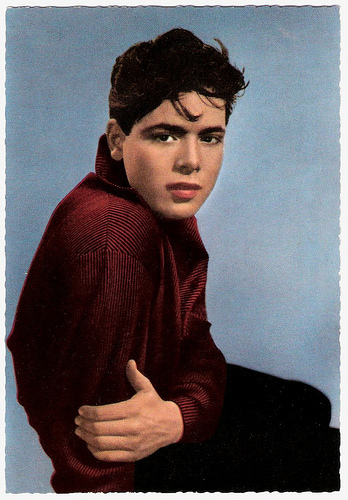
German postcard by ISV, no. H 34.
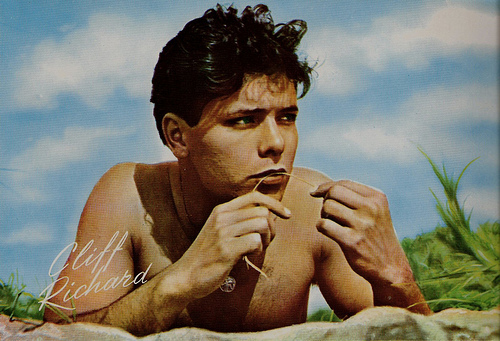
Big Dutch postcard.
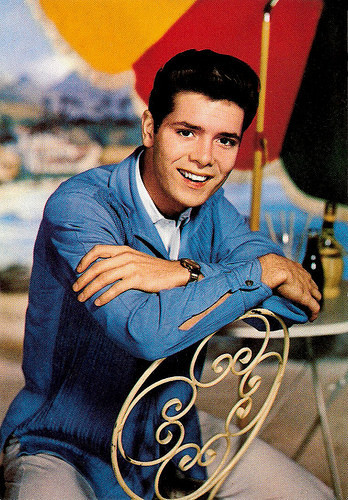
German postcard by ISV, no. T 16. Sent by mail in the Netherlands in 1972.
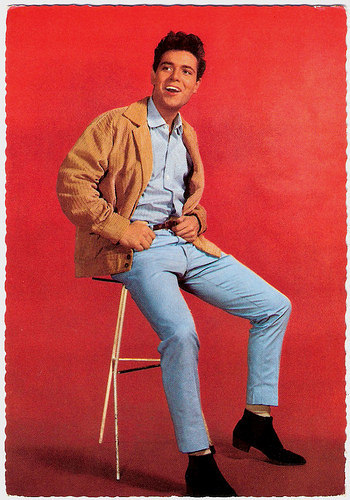
German postcard by ISV, no. T 17.
Rock 'n Roll
Cliff Richard was born Harry Roger Webb in Lucknow, British India, in 1940. He was the son of Rodger Oscar, a train driver of Indian Rail, and Dorothy Marie (born Dazely) Webb. Following India's independence, the family moved to Britain.
In 1957 Harry Webb became interested in skiffle and formed the Quintones vocal group. Later he sang in the Dick Teague Skiffle Group, and then became lead singer of a rock and roll group, The Drifters. In 1958, the group adopted the name Cliff Richard and the Drifters.
The handsome singer burst onto the rock 'n roll world in 1958 with his debut single Move It, originally the B-side. The single went to no. 2 on the UK charts. Music critics Roy Carr and Tony Tyler wrote that it was 'the first genuine British rock classic'.
Cliff adopted an Elvis Presley-like dress and hairstyle. In performance he struck a pose of rock attitude, rarely smiling or looking at the audience or camera. His late 1958 and early 1959 follow-up singles, High Class Baby and Livin' Lovin' Doll, were followed by Mean Streak which carried a rocker's sense of speed and passion, and Living Doll by Lionel Bart.
Living Doll (1958) became the first of fourteen #1 singles in the UK for Cliff. Living Doll triggered also a softer, more relaxed, sound. By that time The Drifters' lineup had changed with the arrival of Jet Harris, Tony Meehan, Hank Marvin, and Bruce Welch. The group was obliged to change its name after legal complications with the American soul group The Drifters and the new name was The Shadows. Their subsequent hits, the no. 1's Travellin' Light and I Love You cemented Cliff's status as a mainstream pop entertainer.
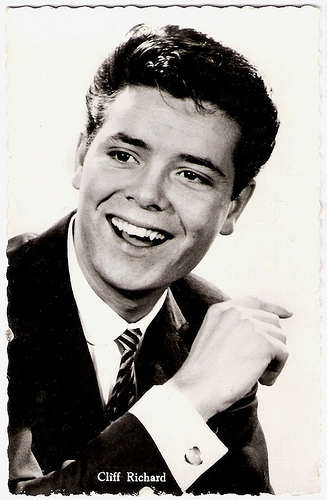
Dutch postcard, sent by mail in 1963. Photo: Columbia.
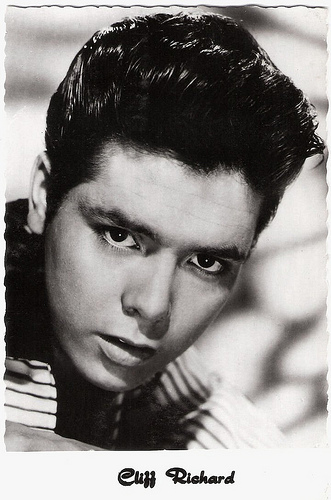
Dutch postcard.
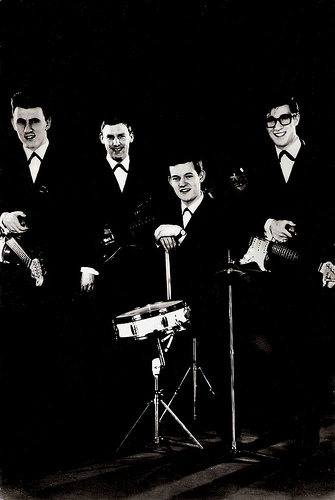
The Shadows. Dutch postcard by Syba, Enkhuizen, no. 22.
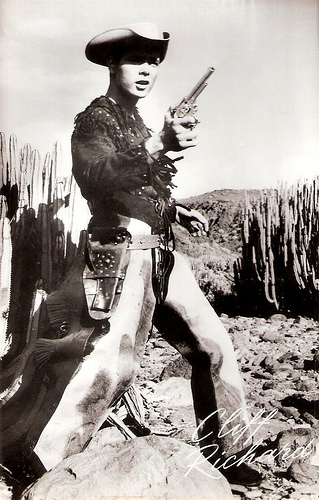
Dutch postcard by 't Sticht, Utrecht, no. AX 6122.
Conversion to Christianity
In 1964 Cliff Richard announced his conversion to Christianity. Initially, he believed that he should quit rock 'n roll, feeling he could no longer be the rocker who had been called a 'crude exhibitionist' and 'too sexy for TV' and a threat to parents' daughters. He re-emerged, performing with Christian groups and recording some Christian material.
Cliff still recorded secular songs with the Shadows, but devoted a lot of his time to Christian work, including appearances with the Billy Graham crusades. He never married and claims to have observed a celibate lifestyle since his conversion. This and the softening of his music led to his having more of a pop than a rock image.
After the Shadows split in 1968, Richard continued to record solo. Twice Cliff Richard represented the United Kingdom at the Eurovision Song Contest: in 1968 and in 1973. In 1968 he sang Congratulations by Bill Martin and Phil Coulter. It lost by just one point to Spain's La La La by Massiel . According to John Kennedy O'Connor's The Eurovision Song Contest — The Official History, this was the closest yet result in the contest and Richard locked himself in the toilet to avoid the nerves of the voting.
In May 2008 a Reuters news report claimed that voting in the competition had been fixed by the host country's dictator leader, Francisco Franco, to ensure that the Spanish entry won, allowing them to host the contest the following year. In particular, it is claimed that Spanish television executives offered to buy programmes in exchange for votes. This has not been proved beyond doubt, but it is thought to be likely. Eurovision later ended voting by national juries in a bid to eradicate such scams.
Nevertheless, Congratulations was a huge hit throughout Europe and yet another no. 1. In 1973 he sang the British entry Power to All Our Friends. This time the song finished third, close behind Luxembourg's Tu Te Reconnaîtras by Anne-Marie David and Spain's Eres Tú by Mocedades. Richard had taken Valium in order to overcome his nerves and his manager was almost unable to wake him for the performance.
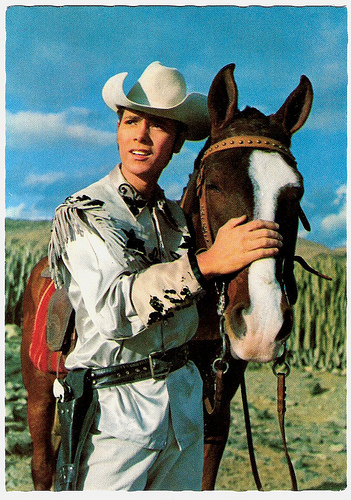
German postcard by ISV, no. T 12.
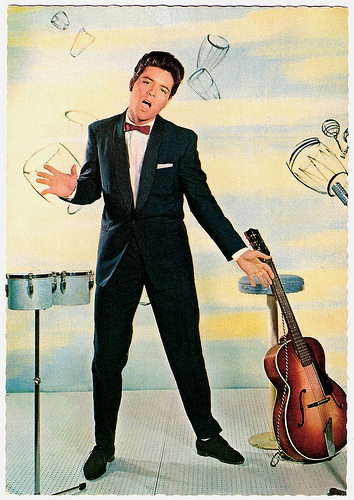
Dutch postcard by Gebr. Spanjersberg N.V., Rotterdam.
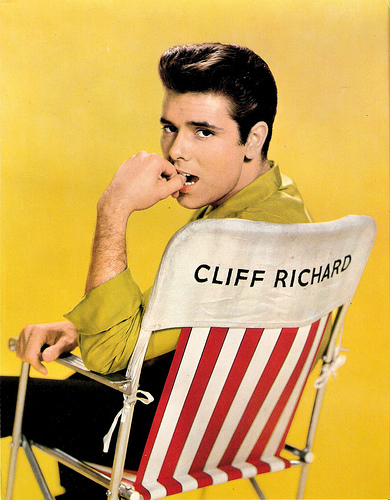
Big German postcard by ISV, no. HX 103.
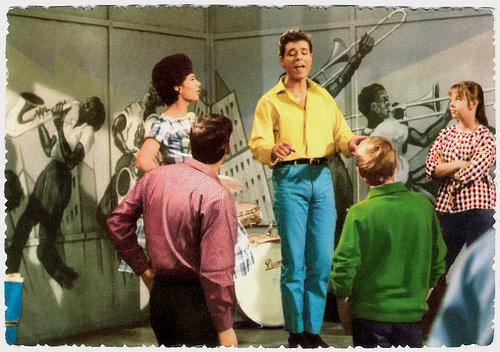
Spanish postcard, no. 4. Photo: British Pathe. Publicity still for The Young Ones (Sidney J. Furie, 1961).
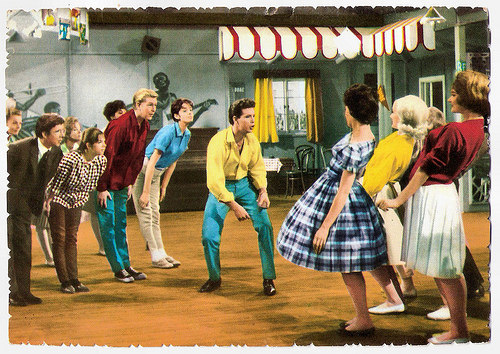
Spanish postcard, no. 18. Photo: British Pathe. Publicity still for The Young Ones (Sidney J. Furie, 1961).
Straight Acting
Cliff Richard’s first film was Serious Charge (Terence Young, 1959), followed by Expresso Bongo (Val Guest, 1959).
In 1961 he filmed The Young Ones (Sidney J. Furie, 1961) and the title track gave him another no. 1 with more than one million sales. The film was an enormous success in the many countries where it was released.
The follow-up Summer Holiday (Peter Yates, 1963) featured a slimmed-down Richard with visible dancing skills. At the premiere, huge crowds prevented him reaching the cinema on time. These films created their own genre, known as the 'Cliff Richard musical'. Cliff was the number one cinema box office attraction in Britain for both 1962 and 1963.
His next film, Wonderful Life (Sidney J. Furie, 1964) was not as successful as his other teen musicals. In 1966, Richard and the Shadows appeared as marionettes in the film Thunderbirds Are GO (Gerry Anderson, 1966).
His first straight acting role took place in Two a Penny (James F. Collier, 1968), in which he played a young man who gets involved in drug dealing while questioning his life after his girlfriend changes her attitude. His other films were Finders Keepers (Sidney Hayers, 1966) and Take Me High (David Askey, 1973).
As with the other existing rock acts in Britain, Richard's career was affected by the sudden advent of The Beatles and the Mersey sound in 1963 and 1964. However, his popularity was established enough to allow him to weather the storm and continue to have hits in the charts throughout the 1960s, albeit not at the level that he had enjoyed before.
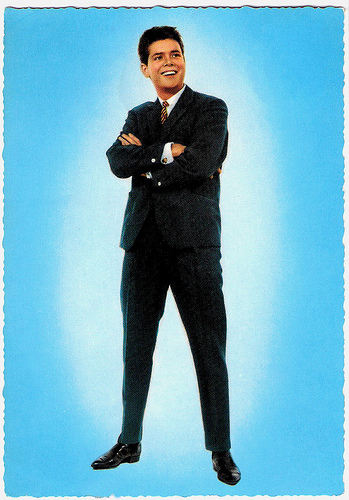
German postcard by Krüger. Sent by mail in the Netherlands in 1965. Photo: Columbia.
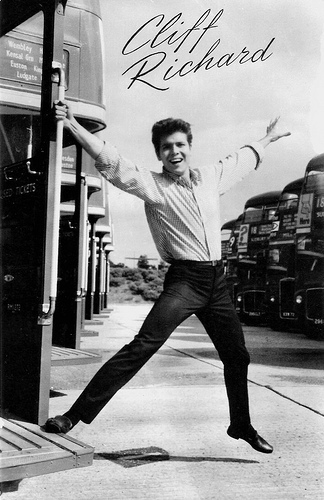
Dutch postcard by Uitg. Takken, Utrecht, no. AX 5465.
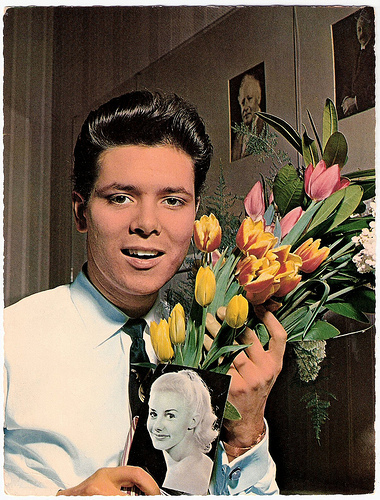
Big Dutch postcard by Gebr. Spanjersberg N.V., Rotterdam, no. 125.
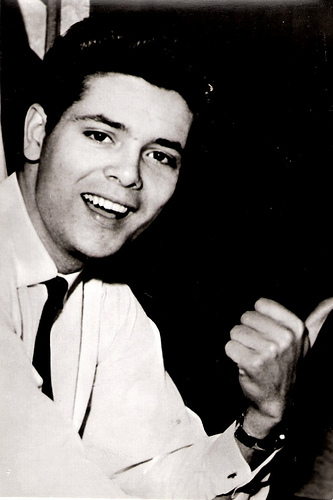
Vintage postcard.
Repackaged
In 1976 the decision was made to repackage Cliff Richard as a 'rock' artist. That year he produced the landmark album I'm Nearly Famous, which included the successful but controversial guitar-driven track Devil Woman (Richard's first true hit in the United States) and the ballad Miss You Nights. His fans were excited that he was getting back into the heavier rock in which he had begun his career.
In 1979, Richard teamed up with the producer Bruce Welch for the pop hit single We Don't Talk Anymore, which hit no. 1 in the UK and no. 7 in the US. Bryan Ferry added the backing vocals to the song. It was his first time at the top of the UK singles chart in over ten years, and the song would become his biggest-selling single ever.
In 1987 Cliff Richard again reached again number one in the UK with Mistletoe and Wine. The popular TV sitcom The Young Ones took its name from Richard's 1962 film, and also made references to the singer. In 1986, Richard teamed up with the cast to re-record his smash hit Living Doll for the charity Comic Relief. Along with the song, the recording contained comedy dialogue between Richard and The Young Ones. This release went also to no. 1.
In 1995 Cliff Richard was knighted, the first rock star to be honoured so. In 1999, controversy arose regarding radio stations refusing to play his releases when EMI, Richard's label since 1958, refused to release his latest song, Millennium Prayer. Richard took it to an independent label, Papillon, which released the charity recording (in aid of Children's Promise). The single went on to top the UK chart for three weeks, his fourteenth no.1, and the third highest-selling single of his career.
Cliff and The Shadows reunited and started a Final Reunion tour in the autumn of 2009. In October 2010, Cliff did six concerts at the Royal Albert Hall in London. The Bold As Brass concerts ran across the week of his 70th birthday and also coincided with the release of his eponymous album. In October 2015, Richard performed on tour to mark his 75th birthday.
During the nearly 60 years in which he has now been active, Cliff Richard reportedly sold over 250 million records. He is the only singer in the history of music to have a #1 hit in the 1950s, 1960s, 1970s, 1980s and 1990s. Cliff Richard divides his time between living in Barbados and at a vineyard property in Portugal.
Trailer for The Young Ones Trailer (1961). Source: HollywoodTeenMovies (YouTube).
Trailer for Summer Holiday (1963). Source: Kevin Allen (YouTube).
Cliff Richard sings Congratulations at the Eurovision Song Contest 1968. Source: escbelgium3 | 1956 - 1979 (YouTube).
Cliff Richard sings Power to All Our Friends at the Eurovision Song Contest 1973. Source: Euroencyclopedic (YouTube).
Sources: Official Cliff Richard Website, , Wikipedia and Eurovision Song Contest official site.

German postcard by Krüger, no. 902/165. Photo: Camera Press / UFA.

German postcard by ISV, no. H 34.

Big Dutch postcard.

German postcard by ISV, no. T 16. Sent by mail in the Netherlands in 1972.

German postcard by ISV, no. T 17.
Rock 'n Roll
Cliff Richard was born Harry Roger Webb in Lucknow, British India, in 1940. He was the son of Rodger Oscar, a train driver of Indian Rail, and Dorothy Marie (born Dazely) Webb. Following India's independence, the family moved to Britain.
In 1957 Harry Webb became interested in skiffle and formed the Quintones vocal group. Later he sang in the Dick Teague Skiffle Group, and then became lead singer of a rock and roll group, The Drifters. In 1958, the group adopted the name Cliff Richard and the Drifters.
The handsome singer burst onto the rock 'n roll world in 1958 with his debut single Move It, originally the B-side. The single went to no. 2 on the UK charts. Music critics Roy Carr and Tony Tyler wrote that it was 'the first genuine British rock classic'.
Cliff adopted an Elvis Presley-like dress and hairstyle. In performance he struck a pose of rock attitude, rarely smiling or looking at the audience or camera. His late 1958 and early 1959 follow-up singles, High Class Baby and Livin' Lovin' Doll, were followed by Mean Streak which carried a rocker's sense of speed and passion, and Living Doll by Lionel Bart.
Living Doll (1958) became the first of fourteen #1 singles in the UK for Cliff. Living Doll triggered also a softer, more relaxed, sound. By that time The Drifters' lineup had changed with the arrival of Jet Harris, Tony Meehan, Hank Marvin, and Bruce Welch. The group was obliged to change its name after legal complications with the American soul group The Drifters and the new name was The Shadows. Their subsequent hits, the no. 1's Travellin' Light and I Love You cemented Cliff's status as a mainstream pop entertainer.

Dutch postcard, sent by mail in 1963. Photo: Columbia.

Dutch postcard.

The Shadows. Dutch postcard by Syba, Enkhuizen, no. 22.

Dutch postcard by 't Sticht, Utrecht, no. AX 6122.
Conversion to Christianity
In 1964 Cliff Richard announced his conversion to Christianity. Initially, he believed that he should quit rock 'n roll, feeling he could no longer be the rocker who had been called a 'crude exhibitionist' and 'too sexy for TV' and a threat to parents' daughters. He re-emerged, performing with Christian groups and recording some Christian material.
Cliff still recorded secular songs with the Shadows, but devoted a lot of his time to Christian work, including appearances with the Billy Graham crusades. He never married and claims to have observed a celibate lifestyle since his conversion. This and the softening of his music led to his having more of a pop than a rock image.
After the Shadows split in 1968, Richard continued to record solo. Twice Cliff Richard represented the United Kingdom at the Eurovision Song Contest: in 1968 and in 1973. In 1968 he sang Congratulations by Bill Martin and Phil Coulter. It lost by just one point to Spain's La La La by Massiel . According to John Kennedy O'Connor's The Eurovision Song Contest — The Official History, this was the closest yet result in the contest and Richard locked himself in the toilet to avoid the nerves of the voting.
In May 2008 a Reuters news report claimed that voting in the competition had been fixed by the host country's dictator leader, Francisco Franco, to ensure that the Spanish entry won, allowing them to host the contest the following year. In particular, it is claimed that Spanish television executives offered to buy programmes in exchange for votes. This has not been proved beyond doubt, but it is thought to be likely. Eurovision later ended voting by national juries in a bid to eradicate such scams.
Nevertheless, Congratulations was a huge hit throughout Europe and yet another no. 1. In 1973 he sang the British entry Power to All Our Friends. This time the song finished third, close behind Luxembourg's Tu Te Reconnaîtras by Anne-Marie David and Spain's Eres Tú by Mocedades. Richard had taken Valium in order to overcome his nerves and his manager was almost unable to wake him for the performance.

German postcard by ISV, no. T 12.

Dutch postcard by Gebr. Spanjersberg N.V., Rotterdam.

Big German postcard by ISV, no. HX 103.

Spanish postcard, no. 4. Photo: British Pathe. Publicity still for The Young Ones (Sidney J. Furie, 1961).

Spanish postcard, no. 18. Photo: British Pathe. Publicity still for The Young Ones (Sidney J. Furie, 1961).
Straight Acting
Cliff Richard’s first film was Serious Charge (Terence Young, 1959), followed by Expresso Bongo (Val Guest, 1959).
In 1961 he filmed The Young Ones (Sidney J. Furie, 1961) and the title track gave him another no. 1 with more than one million sales. The film was an enormous success in the many countries where it was released.
The follow-up Summer Holiday (Peter Yates, 1963) featured a slimmed-down Richard with visible dancing skills. At the premiere, huge crowds prevented him reaching the cinema on time. These films created their own genre, known as the 'Cliff Richard musical'. Cliff was the number one cinema box office attraction in Britain for both 1962 and 1963.
His next film, Wonderful Life (Sidney J. Furie, 1964) was not as successful as his other teen musicals. In 1966, Richard and the Shadows appeared as marionettes in the film Thunderbirds Are GO (Gerry Anderson, 1966).
His first straight acting role took place in Two a Penny (James F. Collier, 1968), in which he played a young man who gets involved in drug dealing while questioning his life after his girlfriend changes her attitude. His other films were Finders Keepers (Sidney Hayers, 1966) and Take Me High (David Askey, 1973).
As with the other existing rock acts in Britain, Richard's career was affected by the sudden advent of The Beatles and the Mersey sound in 1963 and 1964. However, his popularity was established enough to allow him to weather the storm and continue to have hits in the charts throughout the 1960s, albeit not at the level that he had enjoyed before.

German postcard by Krüger. Sent by mail in the Netherlands in 1965. Photo: Columbia.

Dutch postcard by Uitg. Takken, Utrecht, no. AX 5465.

Big Dutch postcard by Gebr. Spanjersberg N.V., Rotterdam, no. 125.

Vintage postcard.
Repackaged
In 1976 the decision was made to repackage Cliff Richard as a 'rock' artist. That year he produced the landmark album I'm Nearly Famous, which included the successful but controversial guitar-driven track Devil Woman (Richard's first true hit in the United States) and the ballad Miss You Nights. His fans were excited that he was getting back into the heavier rock in which he had begun his career.
In 1979, Richard teamed up with the producer Bruce Welch for the pop hit single We Don't Talk Anymore, which hit no. 1 in the UK and no. 7 in the US. Bryan Ferry added the backing vocals to the song. It was his first time at the top of the UK singles chart in over ten years, and the song would become his biggest-selling single ever.
In 1987 Cliff Richard again reached again number one in the UK with Mistletoe and Wine. The popular TV sitcom The Young Ones took its name from Richard's 1962 film, and also made references to the singer. In 1986, Richard teamed up with the cast to re-record his smash hit Living Doll for the charity Comic Relief. Along with the song, the recording contained comedy dialogue between Richard and The Young Ones. This release went also to no. 1.
In 1995 Cliff Richard was knighted, the first rock star to be honoured so. In 1999, controversy arose regarding radio stations refusing to play his releases when EMI, Richard's label since 1958, refused to release his latest song, Millennium Prayer. Richard took it to an independent label, Papillon, which released the charity recording (in aid of Children's Promise). The single went on to top the UK chart for three weeks, his fourteenth no.1, and the third highest-selling single of his career.
Cliff and The Shadows reunited and started a Final Reunion tour in the autumn of 2009. In October 2010, Cliff did six concerts at the Royal Albert Hall in London. The Bold As Brass concerts ran across the week of his 70th birthday and also coincided with the release of his eponymous album. In October 2015, Richard performed on tour to mark his 75th birthday.
During the nearly 60 years in which he has now been active, Cliff Richard reportedly sold over 250 million records. He is the only singer in the history of music to have a #1 hit in the 1950s, 1960s, 1970s, 1980s and 1990s. Cliff Richard divides his time between living in Barbados and at a vineyard property in Portugal.
Trailer for The Young Ones Trailer (1961). Source: HollywoodTeenMovies (YouTube).
Trailer for Summer Holiday (1963). Source: Kevin Allen (YouTube).
Cliff Richard sings Congratulations at the Eurovision Song Contest 1968. Source: escbelgium3 | 1956 - 1979 (YouTube).
Cliff Richard sings Power to All Our Friends at the Eurovision Song Contest 1973. Source: Euroencyclopedic (YouTube).
Sources: Official Cliff Richard Website, , Wikipedia and Eurovision Song Contest official site.
Published on June 12, 2016 22:00
Paul van Yperen's Blog
- Paul van Yperen's profile
- 13 followers
Paul van Yperen isn't a Goodreads Author
(yet),
but they
do have a blog,
so here are some recent posts imported from
their feed.



